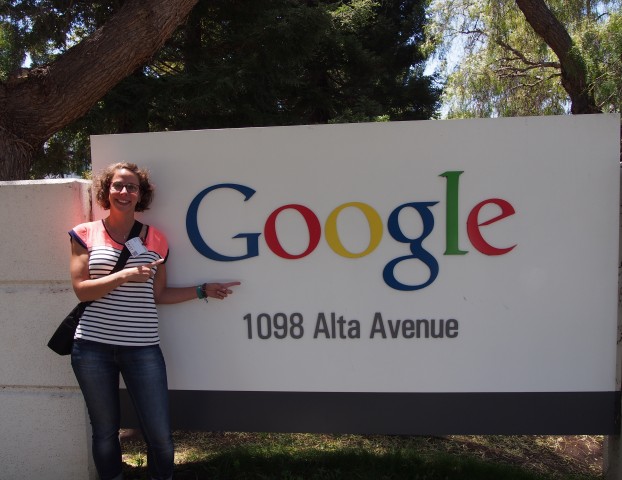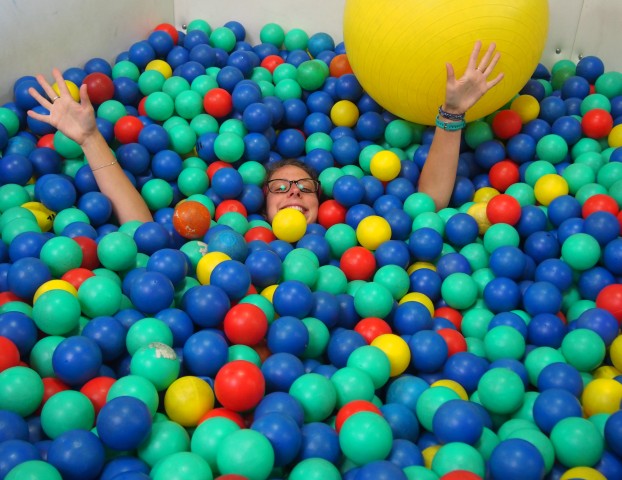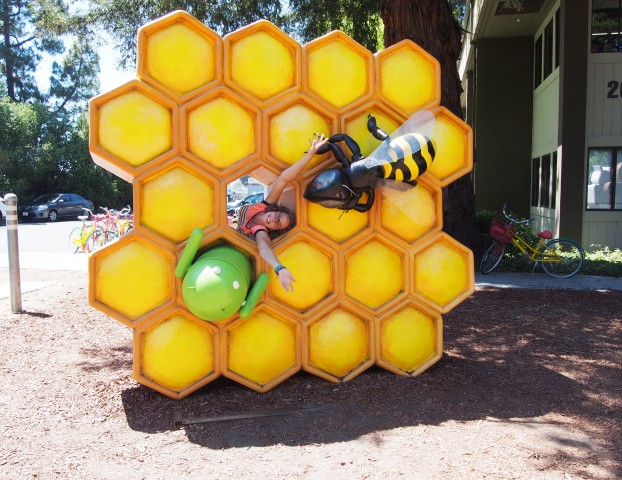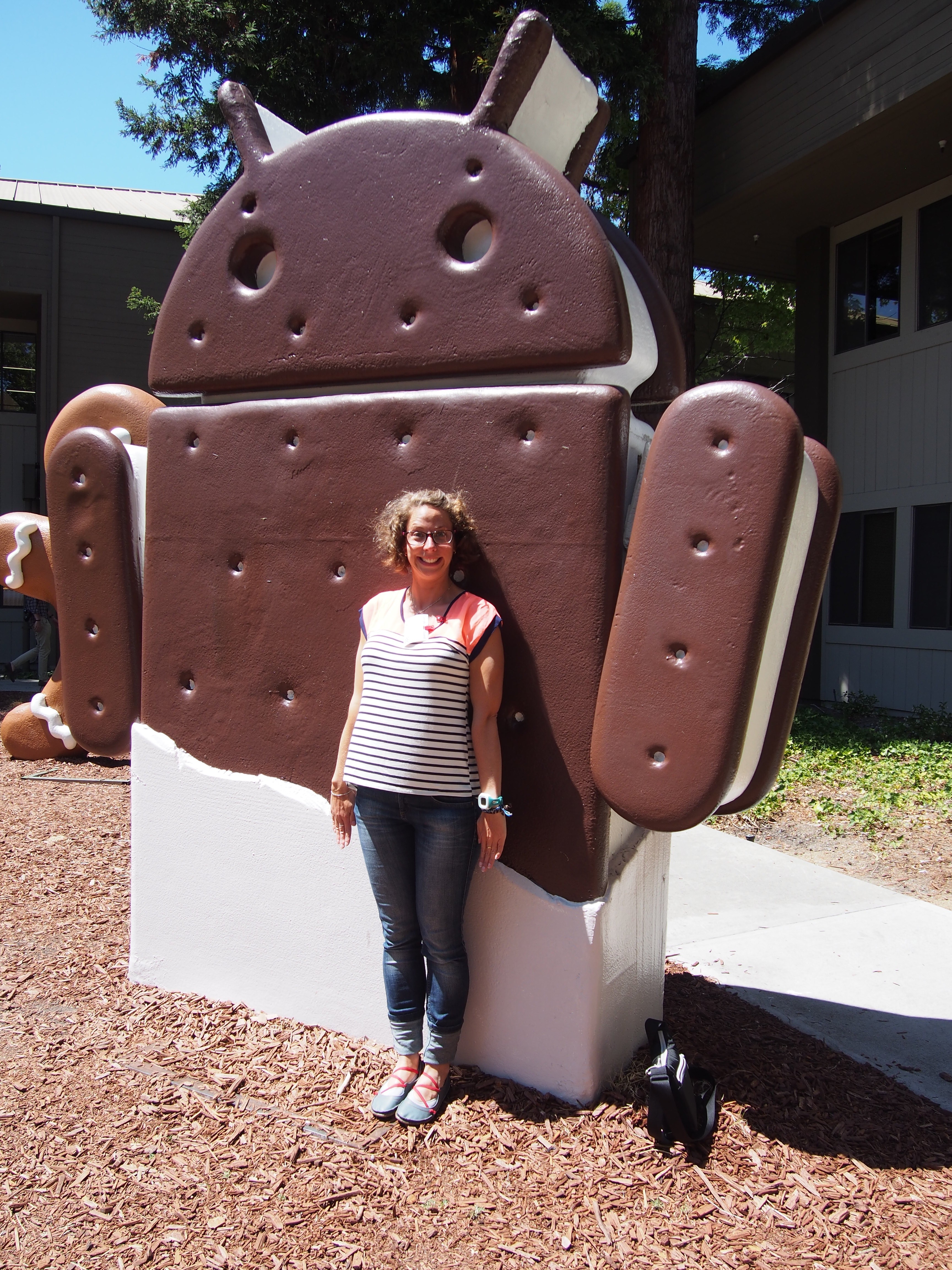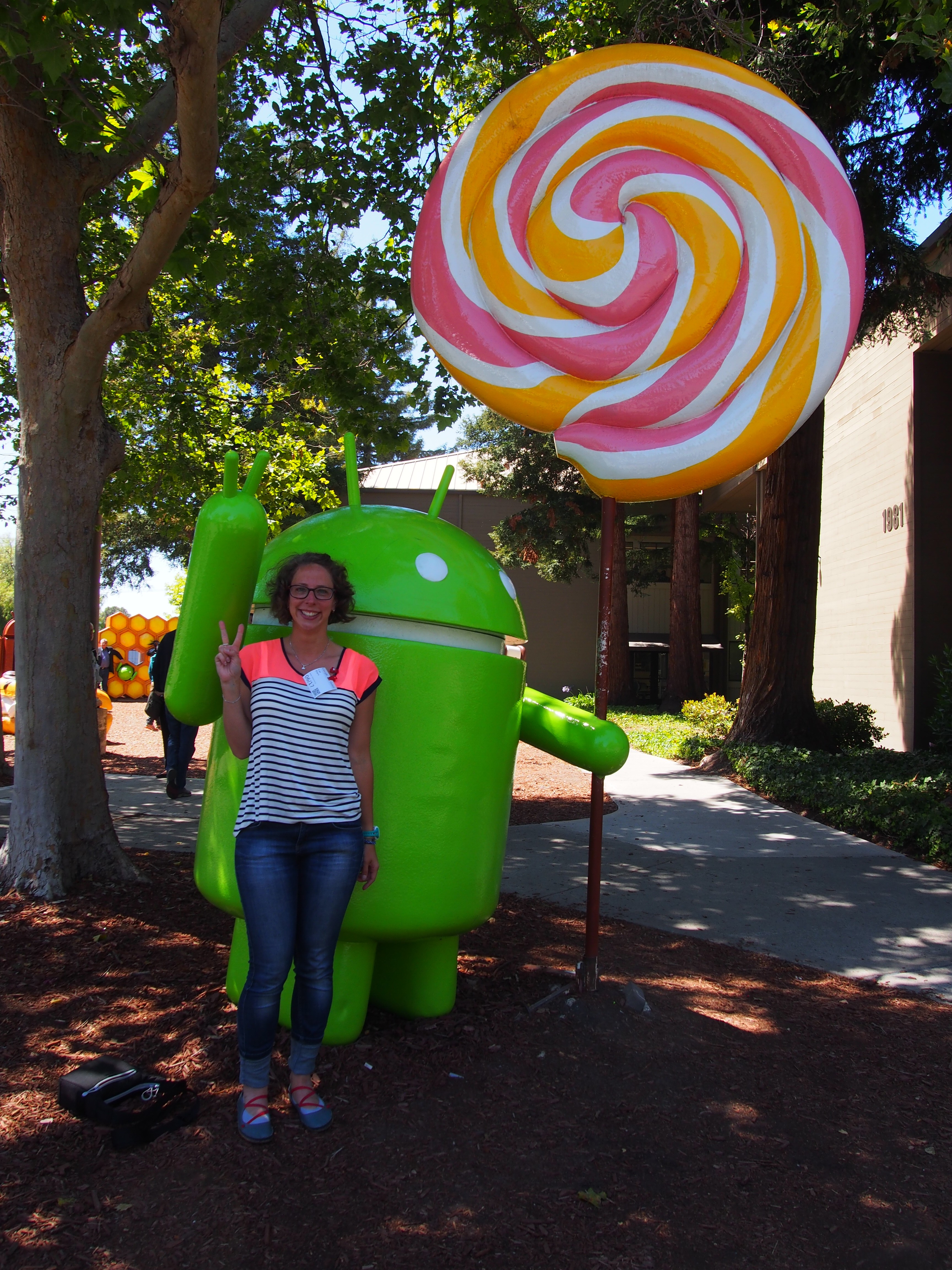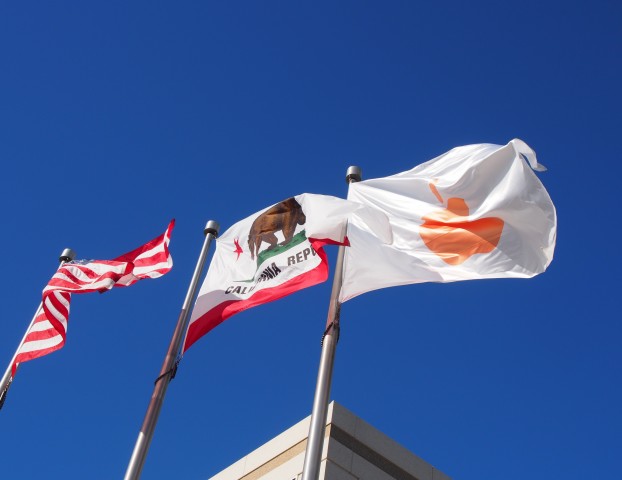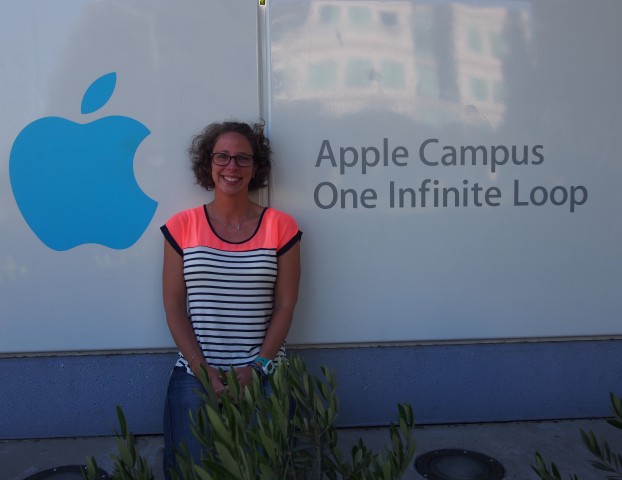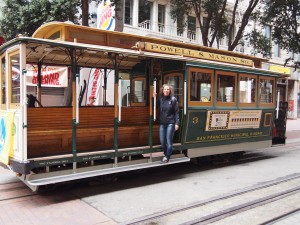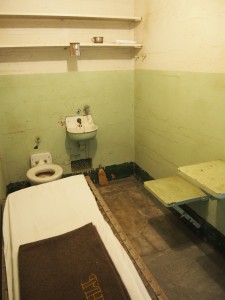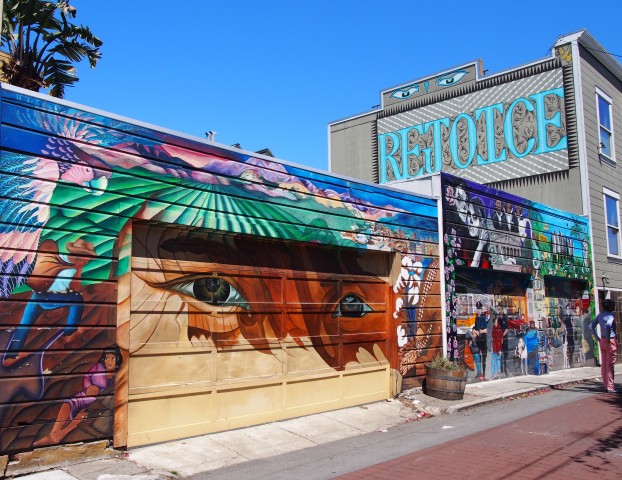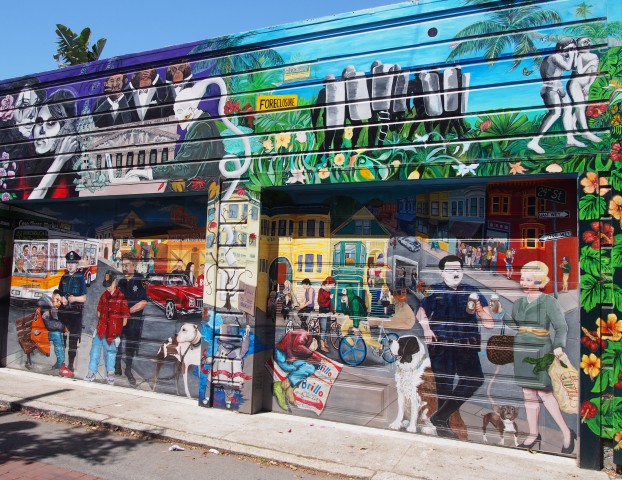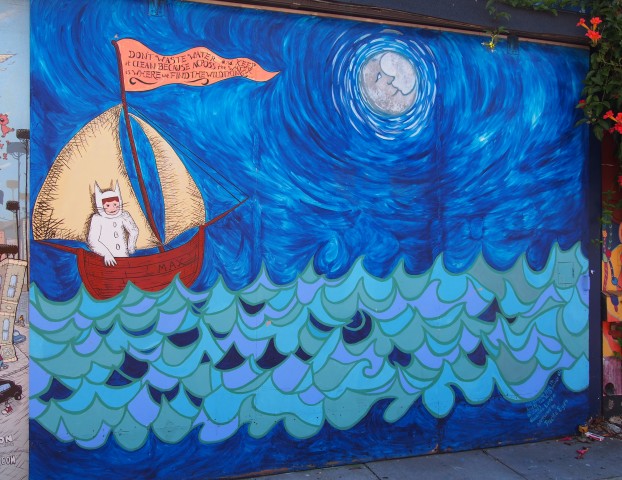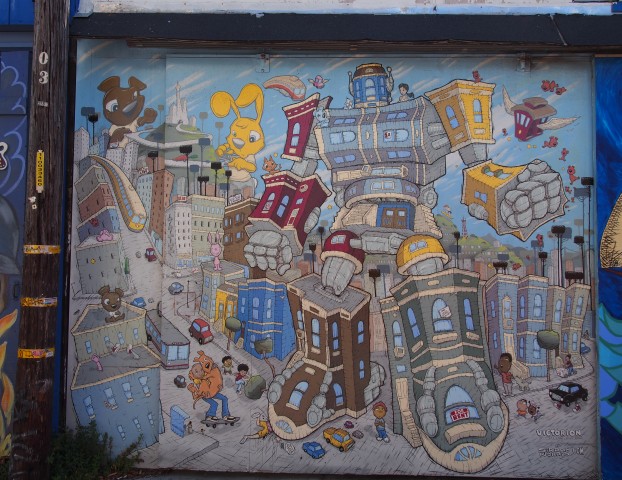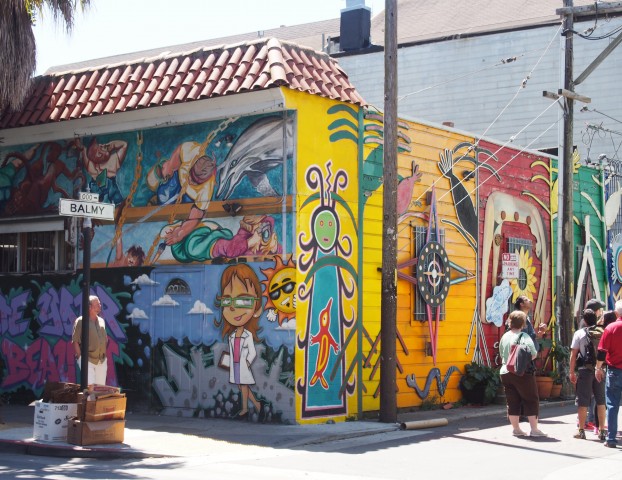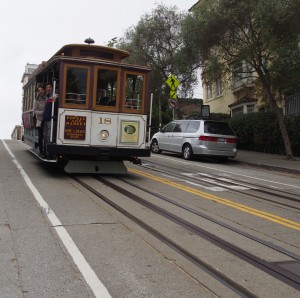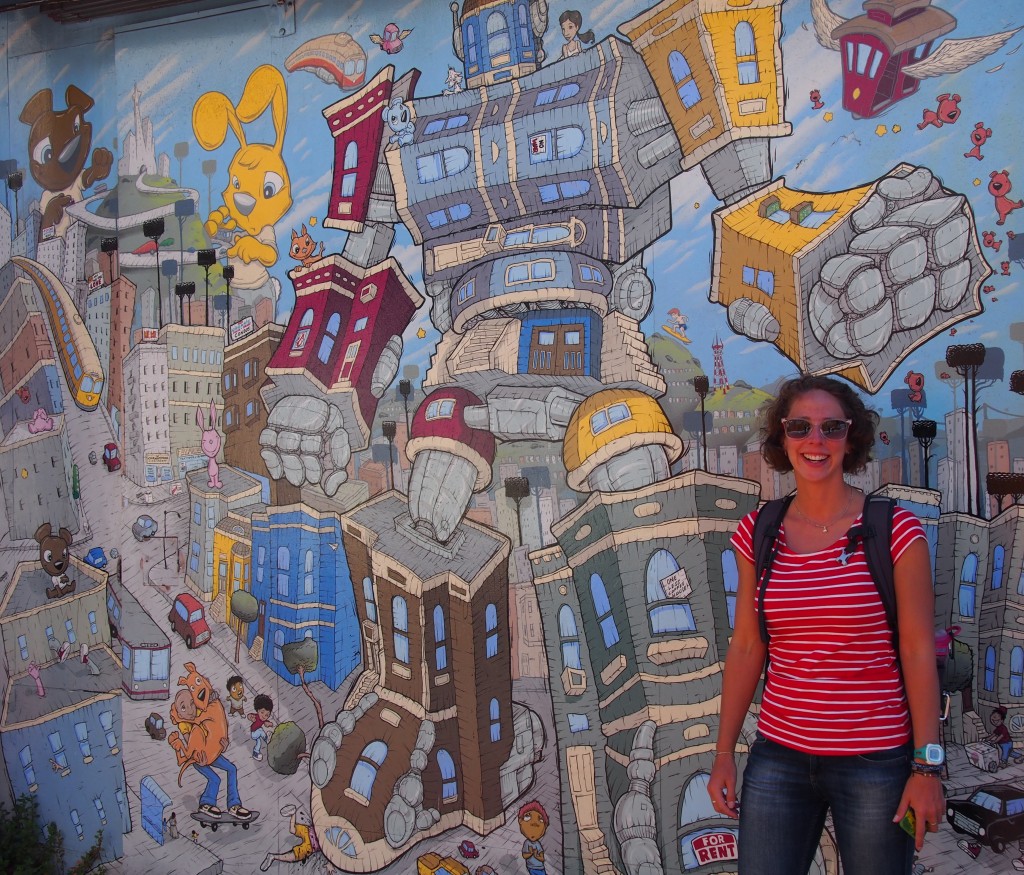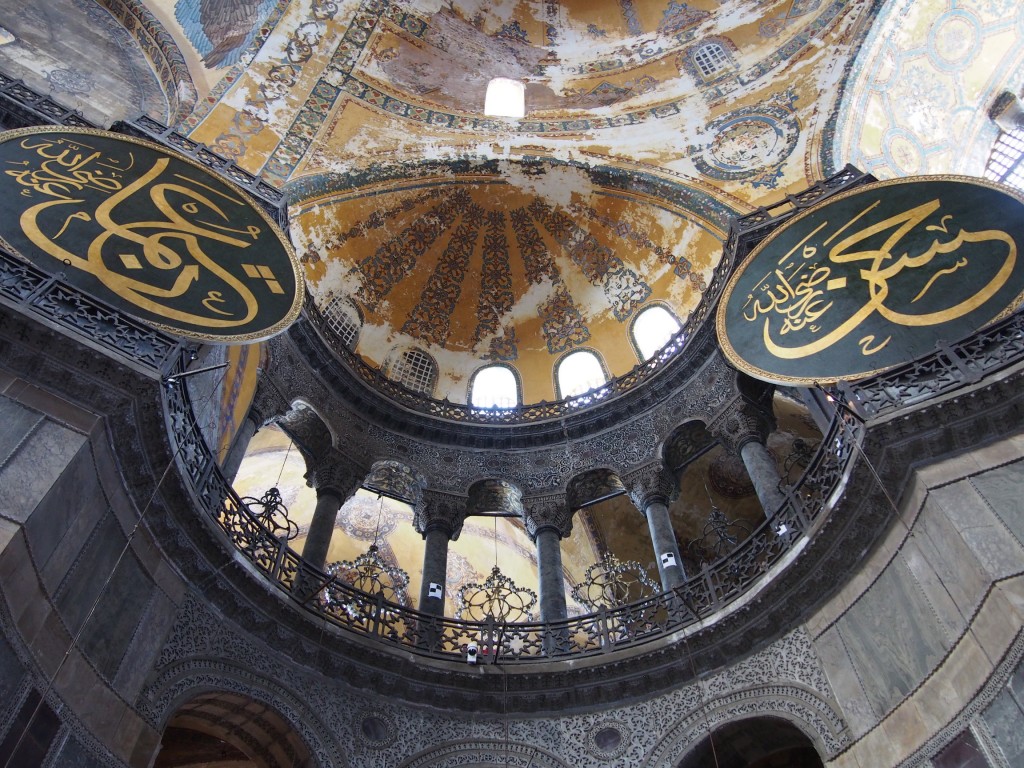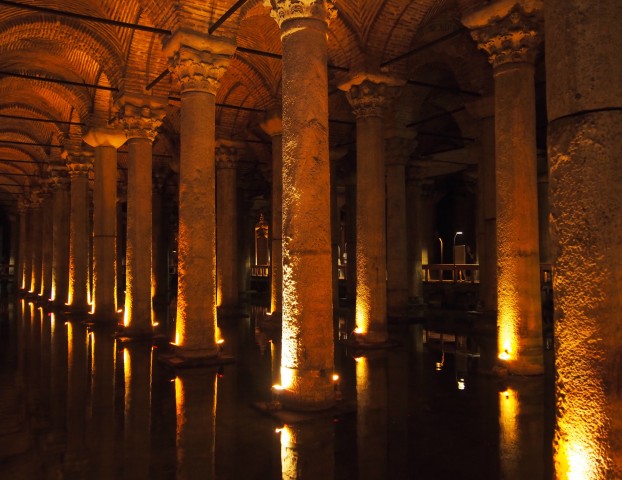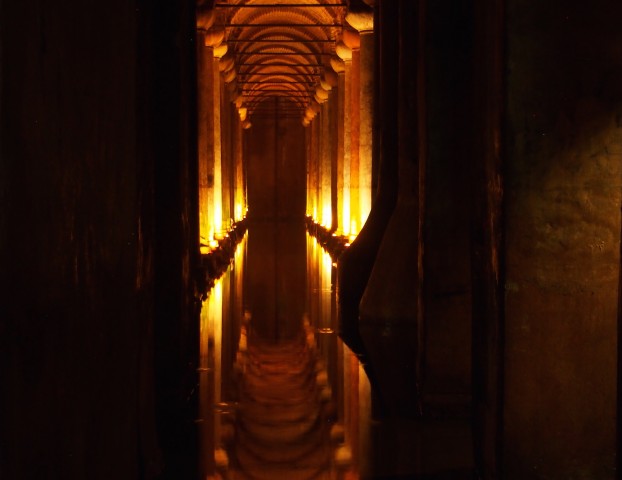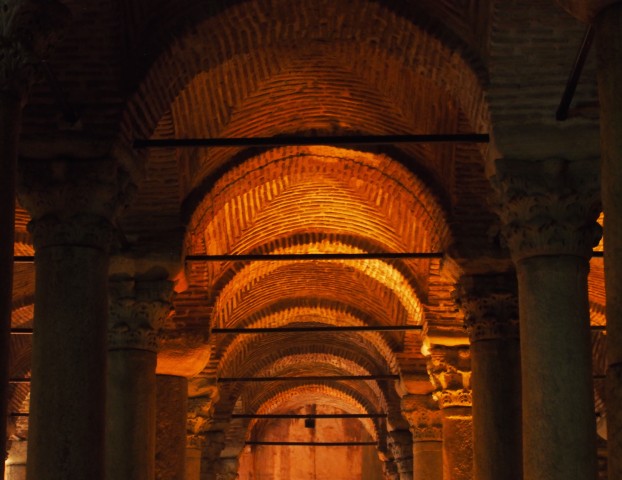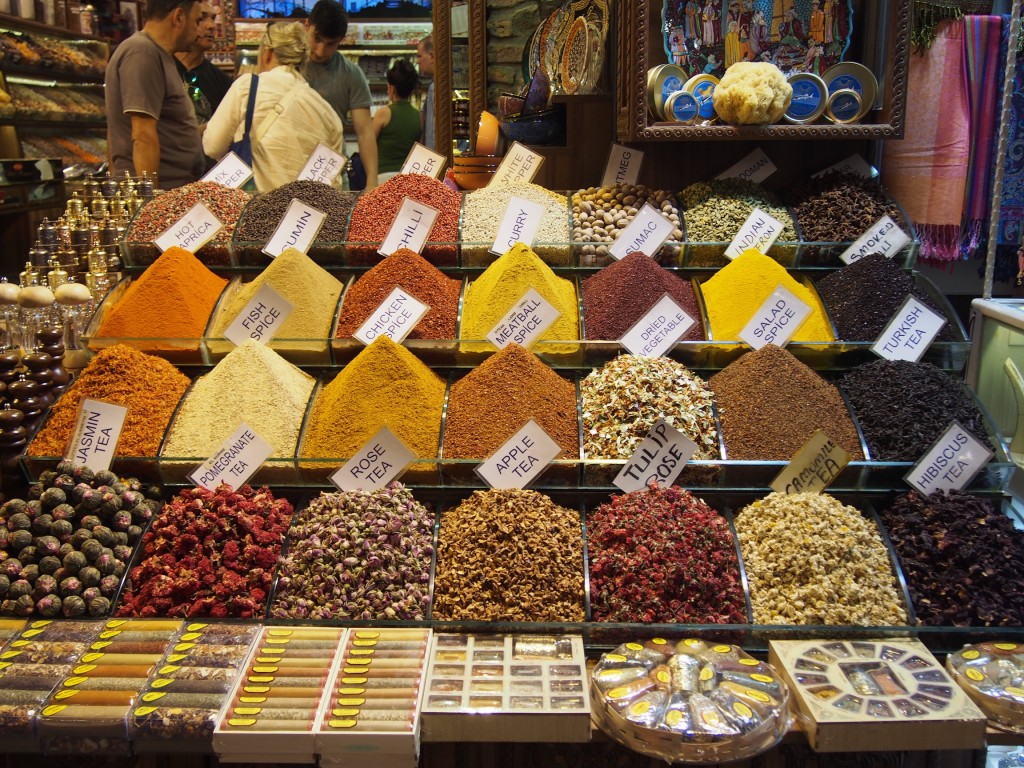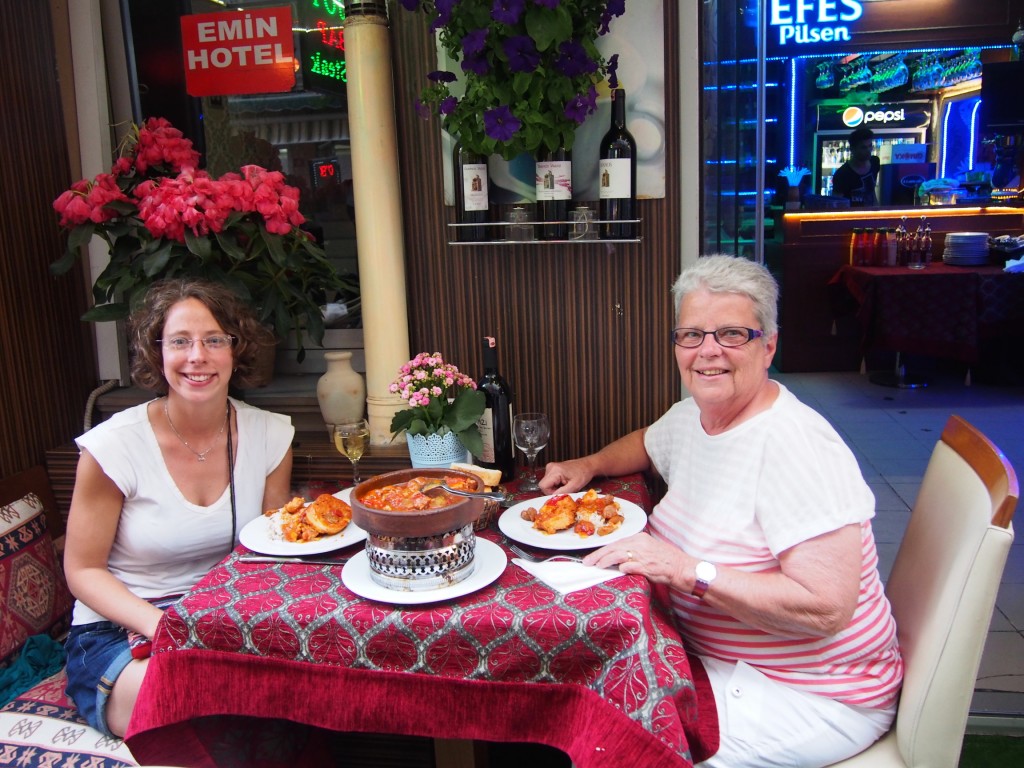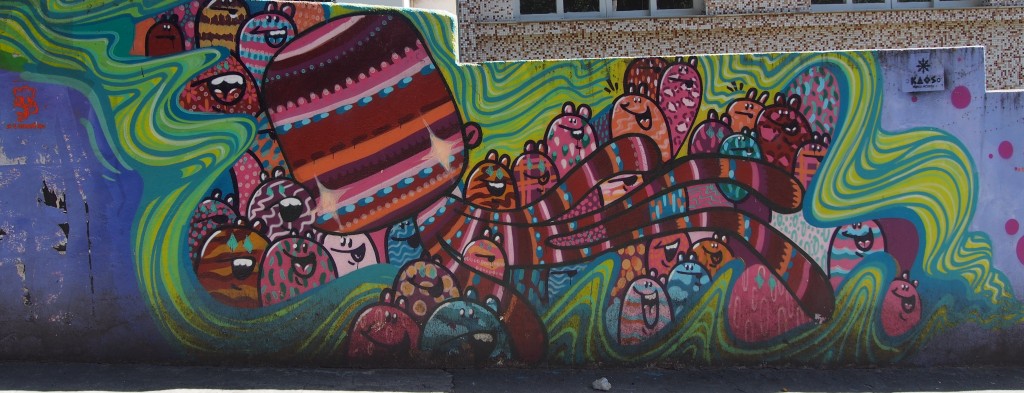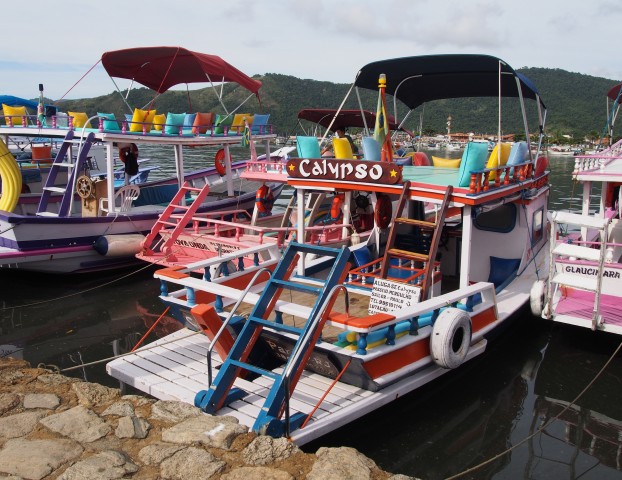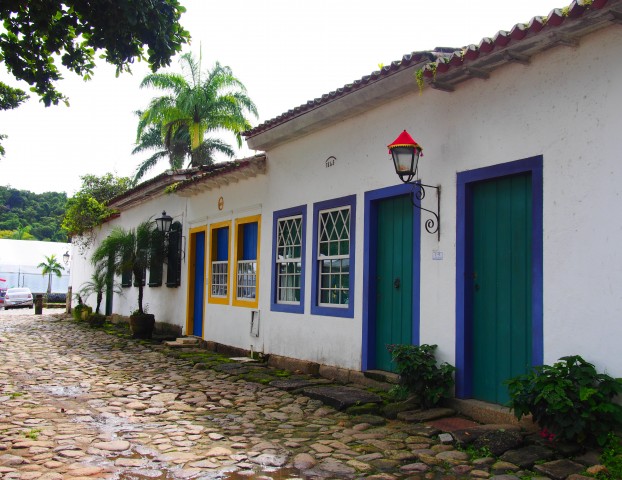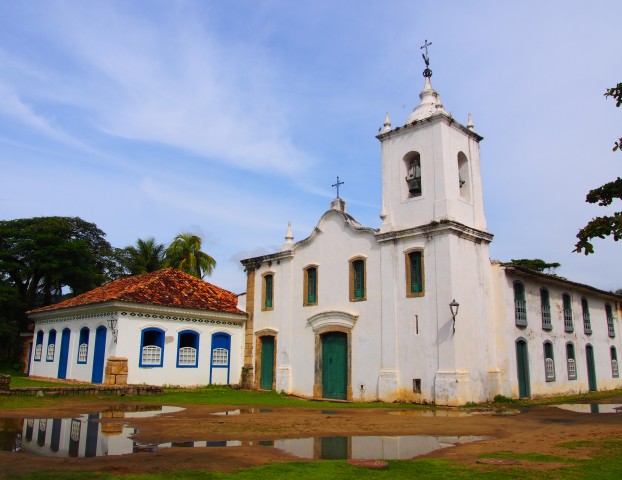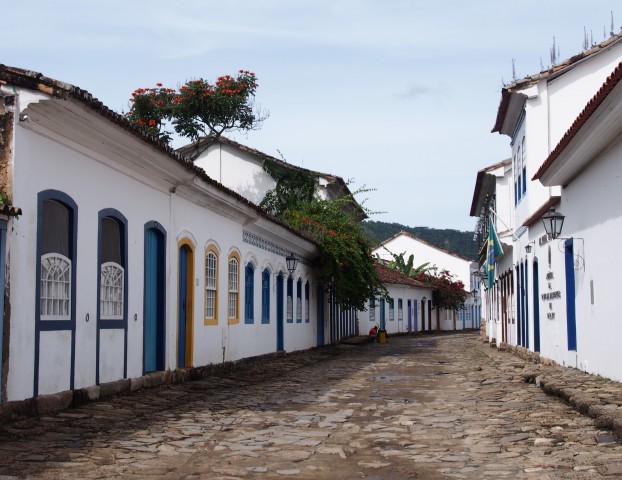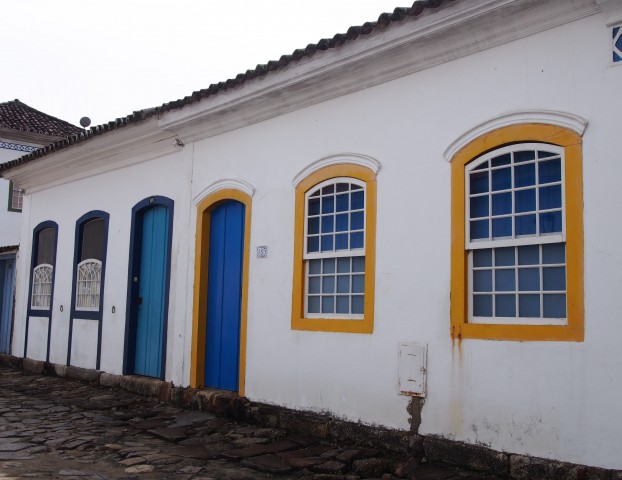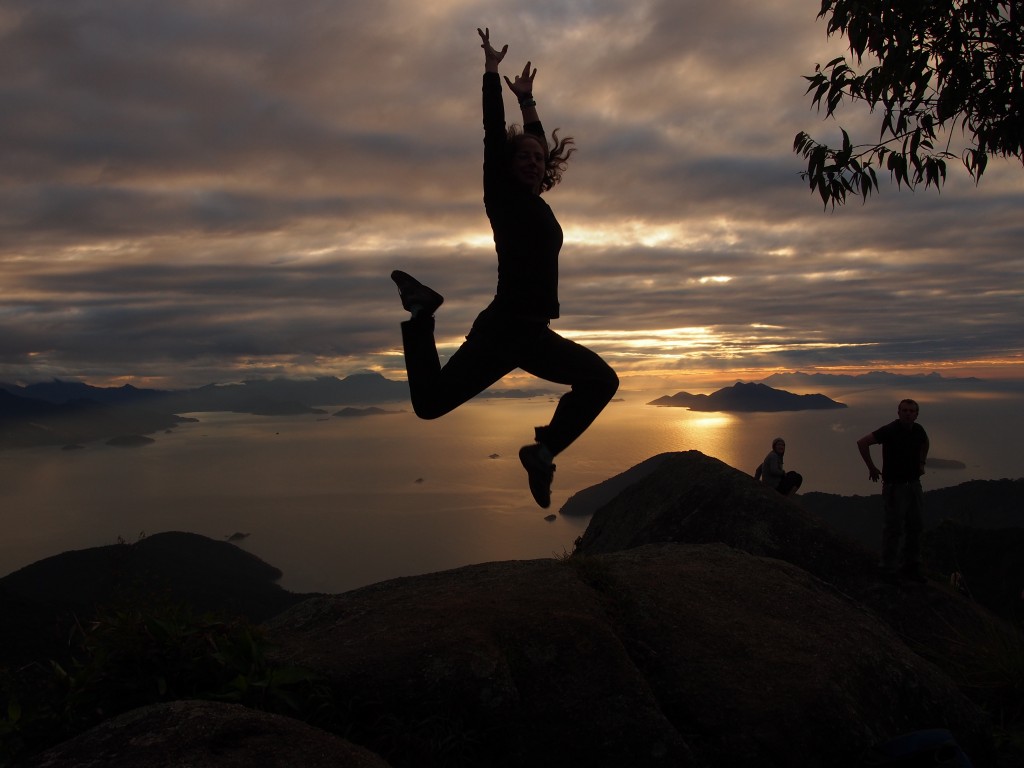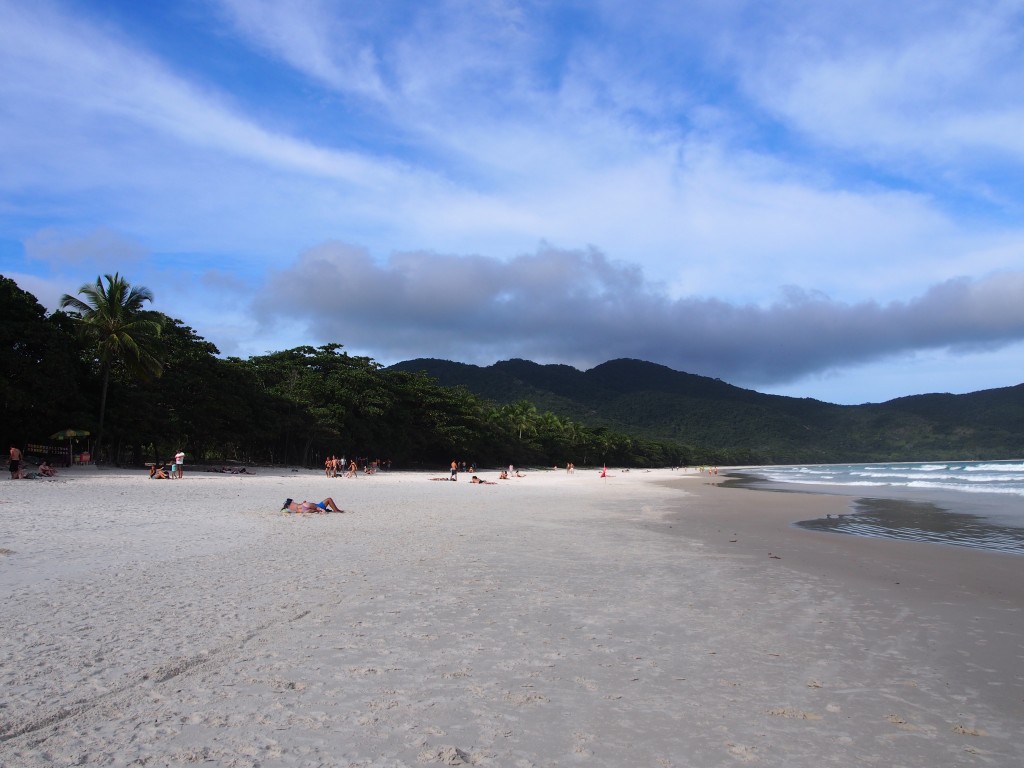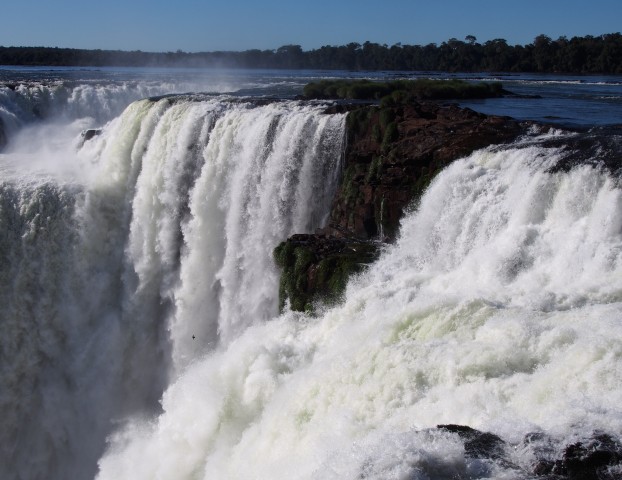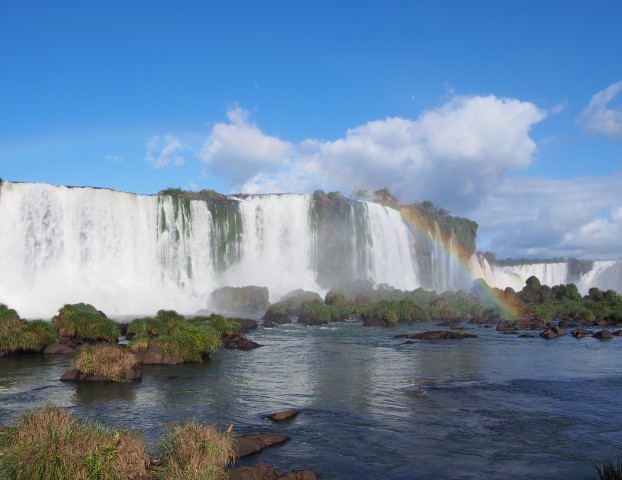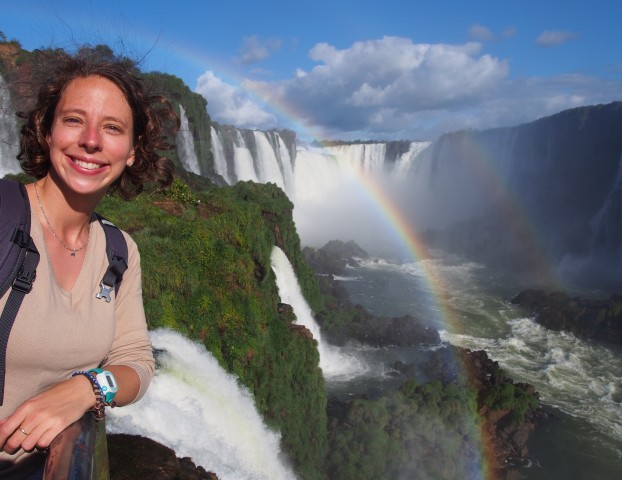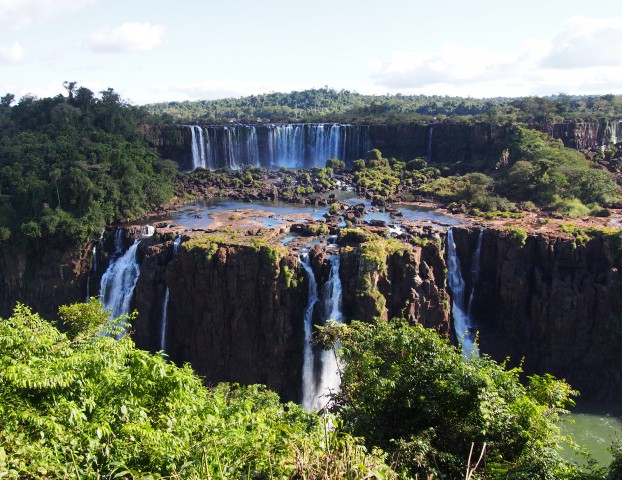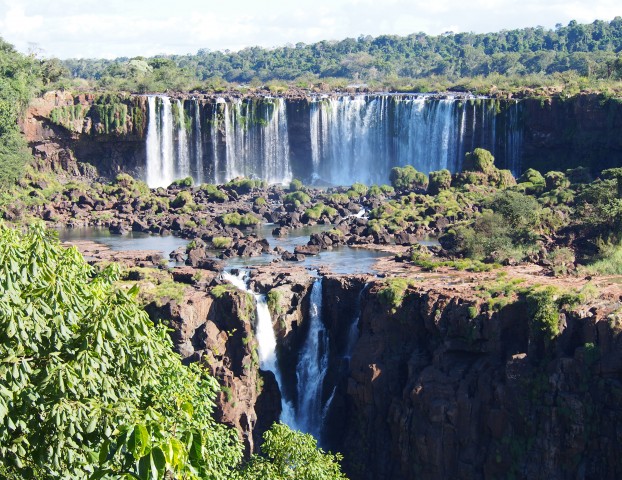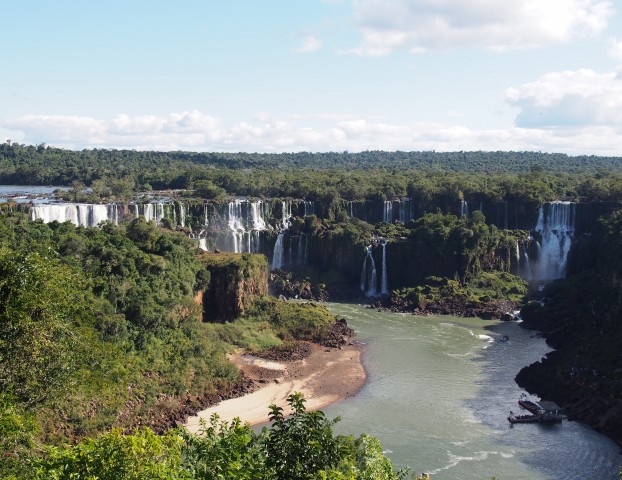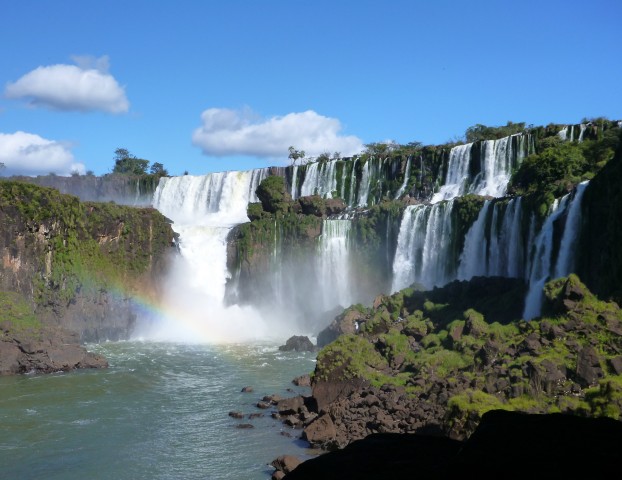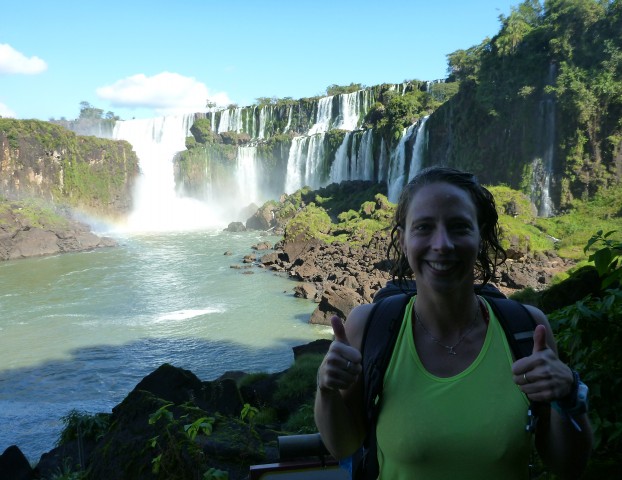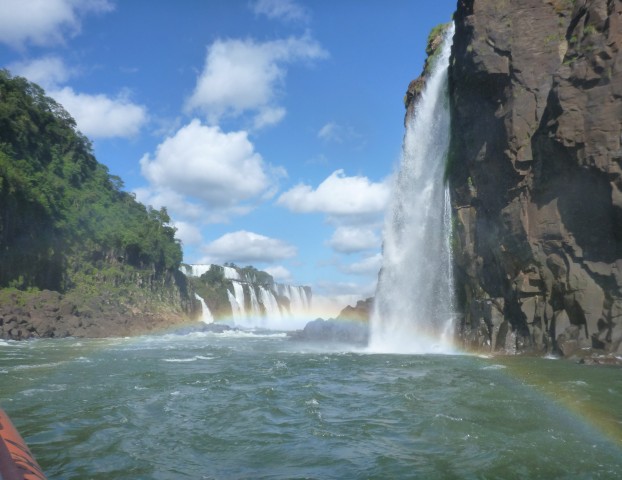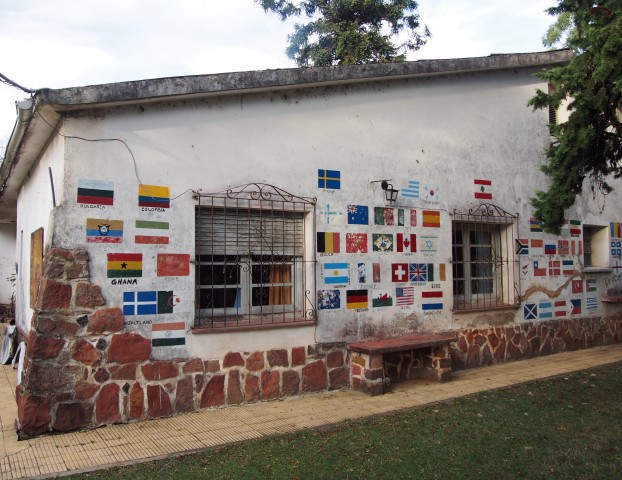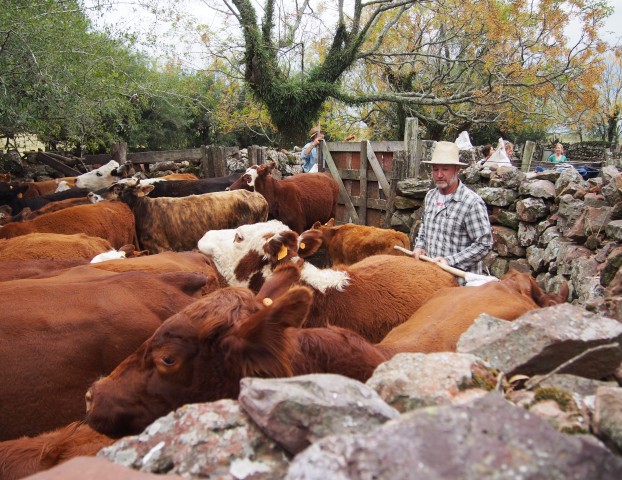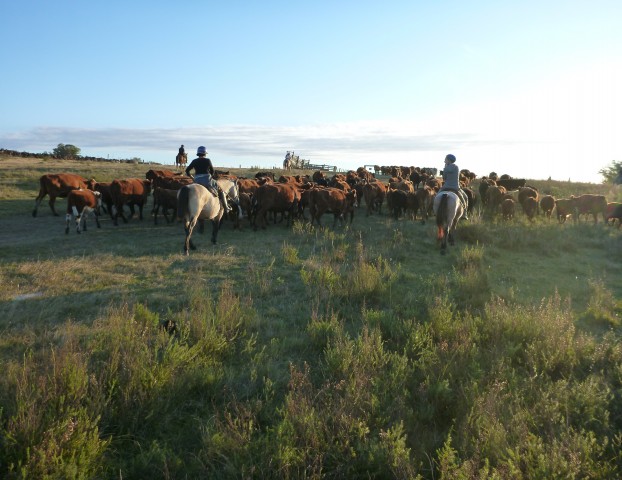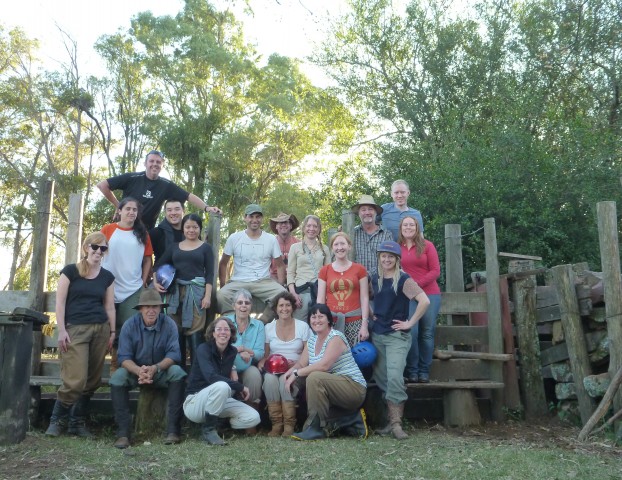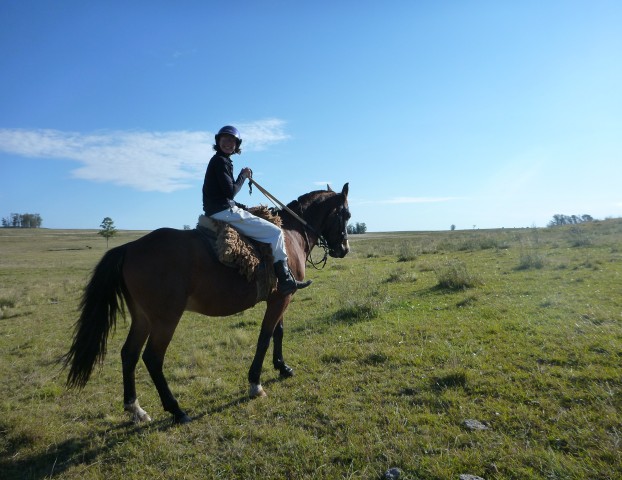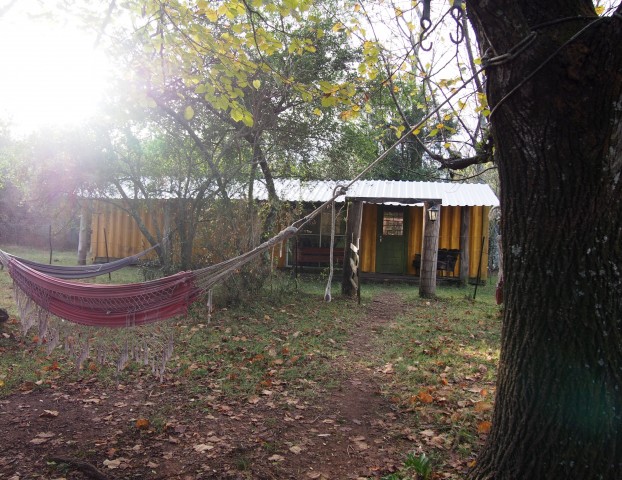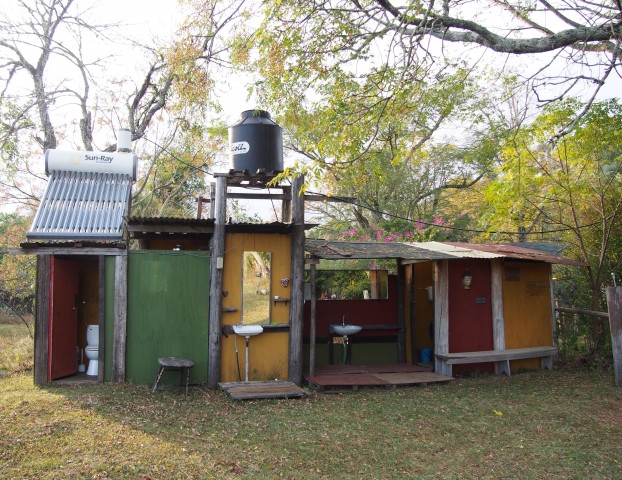As mentioned previously, I’m in the USA because I got a fellowship to do a study tour essentially looking at Tech in Education. This means I am not going to have that many awesome travel posts in the coming weeks. But I thought I’d provide a some quick snaps of some cool places I have been (Google, Apple & Microsoft).
Category Archives: Travel
San Francisco
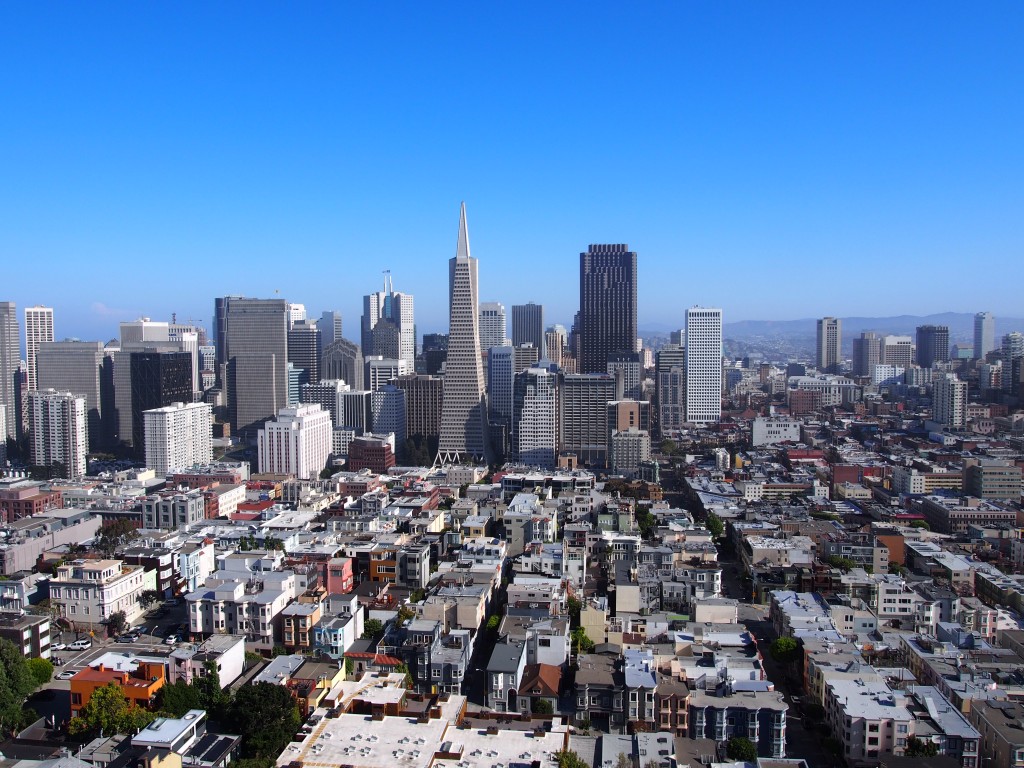
I have made the leap back across the world to the U.S.A where I will be doing a study tour for the next two months, essentially looking at the use of technology in the classroom. While on tour, I will have some opportunities to explore the places I go.
My first stop in the U.S.A has been San Francisco. I had just under a week to explore before the study tour begins. San Francisco is a big city, particularly in light of where I come from. It has a rich culture and so much diversity in the city. Aside from a few key sites, I felt that San Francisco is mostly about exploring the suburbs.
Things to See and Do
Cable Cars
I think one of the things San Francisco is very well known for are it’s crazy steep hills which are tackled by super cute old school cable cars with wooden brakes. At each end of the line, the cable cars are rolled onto a turn table and manually turned around.
These things are so cute it’s not funny! I loved riding the cable cars!
From Powell Street Turnaround there are two lines Powell & Hyde and Powell & Mason. They both take you up and over towards the Fishermans Wharf area. Depending on what you want to see and do, I recommend the Powell & Hyde line and to jump off at the top of the famous Lombard Street. Walk down Lombard and weave your way through the streets towards Fishermans Wharf, or keep walking straight-ish to head up Telegraph Hill to Coit Tower.
Hot Tip: The line to get onto the cable car at Powell Street Turnaround is ridiculous, walk a couple blocks up the street to another cable car stop and get on there.
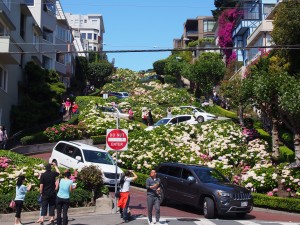 Lombard Street
Lombard Street
Whether there is truth to it or not, the claim is that Lombard Street is the worlds crookedest street. It is a very steep one way street, that runs the length of one block and has eight hairpin turns. It’s definitely worth a look.
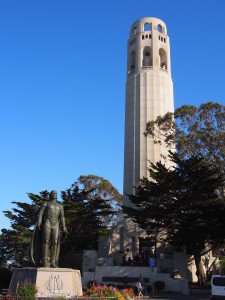
Coit Tower
Coit Tower is at the top of Telegraph Hill and provides a pretty awesome 360 degree view of the city of San Francisco. Be aware that a visit to the top costs $8 and last entry is at around 5:30pm.
Golden Gate Bridge
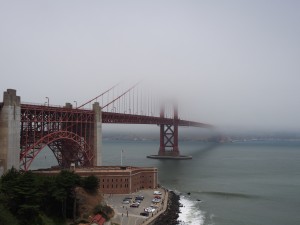 The Golden Gate Bridge, probably the city’s biggest icon. Well known, unfortunately, for being shrouded in fog. There are loads of ways to see the bridge, from mountains, from towers, from boats, walking and cycling. I opted to cycle the bridge together with a girl from my dorm room.
The Golden Gate Bridge, probably the city’s biggest icon. Well known, unfortunately, for being shrouded in fog. There are loads of ways to see the bridge, from mountains, from towers, from boats, walking and cycling. I opted to cycle the bridge together with a girl from my dorm room.
There are about a billion bike rental places to choose from, while it possibly wasn’t the cheapest option, we rented our bikes from San Francisco Bike Rentals on Jefferson Street, west of Pier 41. By reserving a bike online we got a 20% discount off the rental price, and paid $24 to rent a bike for the day (A helmet and a bike lock are included in the price).
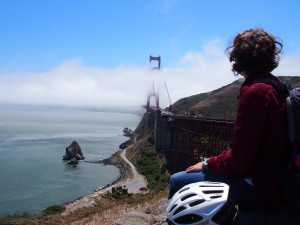 From the Pier 41 area, you follow the coast line. There are loads of photo ops along the way, provided the bridge isn’t completely hidden by fog. You continue along the coast line until you are close to Fort Point (You can cycle to Fort Point for more photos if you choose), then you turn left up Long Avenue, which winds its way up to the bridge.
From the Pier 41 area, you follow the coast line. There are loads of photo ops along the way, provided the bridge isn’t completely hidden by fog. You continue along the coast line until you are close to Fort Point (You can cycle to Fort Point for more photos if you choose), then you turn left up Long Avenue, which winds its way up to the bridge.
The bridge has a reasonably wide path which is shared by cyclists going both directions, as well as pedestrians. Make sure you take it easy! If you want photos, be sure to stop and pull up to the side of the path so that you don’t block traffic.
Once you reach the other side, you could turn around and go back or continue cycling to the historic upper-class town of Sausalito and catch the Ferry (approx. $11) back to the Fishermans Wharf area.
Cycling the bridge is fun but pretty windy, make sure you bring a coat!
Street Cars
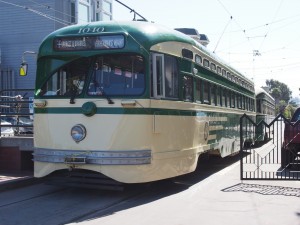 The street cars look a little bit like trams. They are vintage and like the cable cars, super cute! I made good use of the F-line street car which runs all the way along Market Street and then along The Embarcadero (waterfront) to Fishermans Wharf. The route the F-line takes is scenic and gives you a great opportunity to see what there is on offer at each of the piers.
The street cars look a little bit like trams. They are vintage and like the cable cars, super cute! I made good use of the F-line street car which runs all the way along Market Street and then along The Embarcadero (waterfront) to Fishermans Wharf. The route the F-line takes is scenic and gives you a great opportunity to see what there is on offer at each of the piers.
Fishermans Wharf and Pier 39
 The Fishermans Wharf and Pier 39 areas are very commercial. Pier 39 almost feels like you are visiting Disneyland. That being said, I did think they were worth a look. There were some good options for eating out and I made sure I had some ‘famous’ clam chowder in a bread bowl.
The Fishermans Wharf and Pier 39 areas are very commercial. Pier 39 almost feels like you are visiting Disneyland. That being said, I did think they were worth a look. There were some good options for eating out and I made sure I had some ‘famous’ clam chowder in a bread bowl.
Fishermans Wharf is pretty much just food, but Pier 39 has food and many specialty and souvenir shops. At the end, on the west side of Pier 39 is also a sea lion colony, which attracts hordes of tourists!
Alcatraz
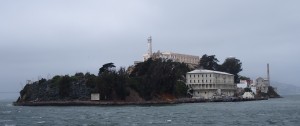 Alcatraz is another San Francisco icon. It is an island (and national park) 1.5 miles off the coast of San Francisco. From 1934 to 1963, it was home to the Alcatraz Federal Penitentiary, a maximum high-security prison.
Alcatraz is another San Francisco icon. It is an island (and national park) 1.5 miles off the coast of San Francisco. From 1934 to 1963, it was home to the Alcatraz Federal Penitentiary, a maximum high-security prison.
We booked tickets to Alcatraz online through Alcatraz Cruises for $30 each. The ticket cost covered the return ferry ride to the island, entry to the national park and an audio tour of the prison.
The ferry ride to the island and the island visit were bitterly cold, which gave an indication to us of just how awful it must have been to be stuck out on “The Rock”. Alcatraz was basically used to house the worst of the worst; the prisoners who caused too much trouble in other prisons. Life on The Rock had very strict routine without too much disruption, though riots in May 1946 due to a failed escape attempt were rather horrendous. Less bloody, was an escape by three inmates who dug out ventilation tunnels with the use of metal spoons and escaped on an inflatable raft made of stolen raincoats.
The prison was interesting to explore and the audio guide that went with it was just fantastic. It was narrated by one of the prison wardens, with additional commentary from various inmates and family members of the prison staff who lived on the island. The narration was accompanied by appropriate and effective sound effects, which created a real sense of place and time.
The View
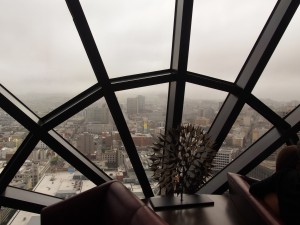 The View cocktail lounge on the 39th floor of the Marriott Marquis Hotel on 4th Street. Unsurprisingly, it has a superb view of the city!
The View cocktail lounge on the 39th floor of the Marriott Marquis Hotel on 4th Street. Unsurprisingly, it has a superb view of the city!
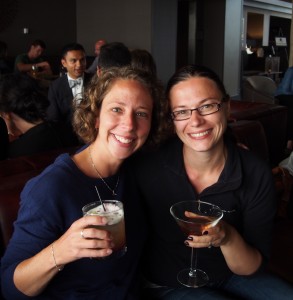 It’s a pretty fancy place, but to my surprise didn’t have a strict dress code. With some friends from home, we turned up in jeans and sneakers. We sat amongst people who had just come from a Giants game and others who were wearing Tuxedo’s and formal dresses.
It’s a pretty fancy place, but to my surprise didn’t have a strict dress code. With some friends from home, we turned up in jeans and sneakers. We sat amongst people who had just come from a Giants game and others who were wearing Tuxedo’s and formal dresses.
This was the perfect spot to sit for a few hours lounging around on sofas, drinking tasty cocktails, watching the sun go down.
Mission
I’m not sure what the Mission District is mostly known for, but what I found there was loads and loads of cool street art, and some good coffee.
The coffee place I checked out was Four Barrel on Valencia Street, they had a great atmosphere and really tasty coffee. As I enjoyed my latte, I did some googling about what to see in the Mission and came up with Balmy Street Murals (Balmy Street is off 24th).
Caffeinated, I jumped on a bus and made my way to Balmy Street, stopping at several alley ways along the way. I noticed that deep in Mission I heard very little english and even the bus announcements had become Spanish only, so I wonder if it is a latino district perhaps.
Anyway the street art was awesome, so many different colours, styles and messages – I loved it!
Castro
 Castro is the Gay and Lesbian district, I had heard that it was a very colourful district in a variety of ways. I think I was there too early in the morning to really experience all the colours on offer, but the man in fishnet booty short provided a bit of an insight.
Castro is the Gay and Lesbian district, I had heard that it was a very colourful district in a variety of ways. I think I was there too early in the morning to really experience all the colours on offer, but the man in fishnet booty short provided a bit of an insight.
The pedestrian crossings in the pride colours and the colourful murals were pretty cool.
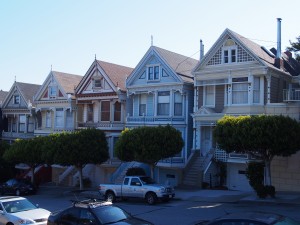 Painted Ladies
Painted Ladies
On Steiner Street just next to Alamo Park are some gorgeous Victorian style buildings, over the top of which the city can be seen. The houses and the view are both beautiful, but I don’t know that it was really something to write home about.
Exploratorium
The Exploratorium is a museum on the waterfront at Pier 15, which is all about learning through exploring. Throughout the museum are workstations that allow you to interact with various gadgets and devices to learn concepts by tinkering and doing. If you are a person curious about how things work, then it is definitely worth a visit.
As a teacher studying technology and investigating the idea of learning by doing, this place was great. It gave me a number of cool ideas for ways in which different things can be taught. I also think that as a place for young people to visit, it’s almost like an educational theme park, loads of fun!
Visits cost $29, but are discounts to $24 for teachers.
Some General Info
Accommodation
I stayed in Hostelling International, San Francisco Downtown. The location was absolutely brilliant, right near Union Square and a short walk to everything downtown. Rooms were a good size, nice and clean. I spent 3 nights in a 4-bed female dorm and 3 nights in a twin private room with a colleague, both with private bathroom. There is a tasty bagel breakfast included, and the wifi is fast and reliable. It’s one of the best hostels I have stayed in.
If you aren’t a HI member you need to pay a bit extra than the listed price, I would recommend buying the eMembership because it quickly pays itself.
Transport
Getting around the city with public transport is crazy easy. I am usually a walker, but with all the really cute public transport ie. cable cars and street cars, not to mention the hills, I opted for public transport instead.
In and around the city I would recommend buying a muni pass. The muni pass gives you access to the cable cars, streets cars, buses and light rail. You can get a day pass for $17, 3-day for $26 or 7-day for $35. The alternate option is to pay around $6 per ride, which adds up very quickly.
You can buy a muni pass from a ticket booth right near the cable car turnaround on Powell Street (just look for where Powell Street meets Market Street)
Food
I’m aiming to travel on the cheap and I’m not much of a foodie, so I don’t like to splash out too much on food. I found that buying frozen meals or pre-packaged salads from Walgreens cost close to the same as eating at a budget restaurant.
For most meals I paid between $9 and $15 for a single main menu item. Most meals in the US are quite big portions, so I never had more than one menu item.
Istanbul
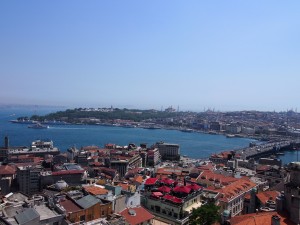 Istanbul is Turkey’s largest city with a population of 18 million people. It’s easy to gauge the sheer size of the city when trying to travel across it in a car. It takes forever to get even just a few blocks.
Istanbul is Turkey’s largest city with a population of 18 million people. It’s easy to gauge the sheer size of the city when trying to travel across it in a car. It takes forever to get even just a few blocks.
My hotel was in the old part of the city and this was absolutely the best place to be. It was just 10-15 minutes walk to any one of the important sites.
At first glance of the map, the old town of Istanbul looks very big and has a labyrinth of winding streets, but I actually found was that was very easy to navigate. On my second day in the city I already left my map at the hotel.
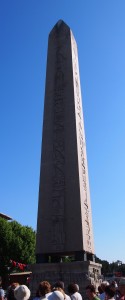 Byzantine Hippodrome
Byzantine Hippodrome
Back when Istanbul was known as Constantinople, during the Byzantine Period a Hippodrome was created in the centre of the city.
It is a U shape and is essentially a race track for horse and chariot racing. The Hippodrome has two obelisks in the centre line of it, one at each end. One is an Egyptian Obelisk called Obelisk of Thutmose III; the other is the Walled Obelisk built by an Emperor in the 10th century.
Sultanahmet Mosque

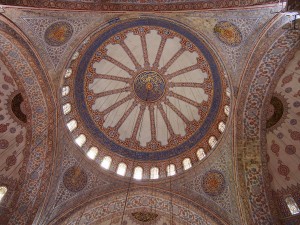 More commonly referred to as the Blue Mosque due to all the blue tiles used for the interior decoration. It is the only mosque with 6 minarets in Istanbul, and one of only 2 in Turkey. It is a 17th century Ottoman mosque, and is still in use. When visiting you are required to take off your shoes; women are required to wear a head covering and ensure that their shoulder and knees are covered too.
More commonly referred to as the Blue Mosque due to all the blue tiles used for the interior decoration. It is the only mosque with 6 minarets in Istanbul, and one of only 2 in Turkey. It is a 17th century Ottoman mosque, and is still in use. When visiting you are required to take off your shoes; women are required to wear a head covering and ensure that their shoulder and knees are covered too.
The mosque is simply stunning, there is so much detail in every aspect of the mosque. The ceilings in particular are amazing to see.
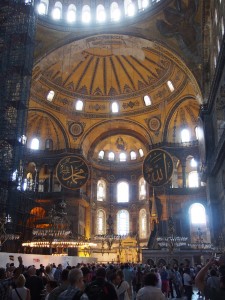 Hagia Sofia
Hagia Sofia
Hagia Sofia is a grand church that was completed in AD537. In 1453 the Ottomans took over the city, called Constantinople at the time, and converted the church to a mosque. In more recent history, 1935, Atatürk converted it to a museum and it is still undergoing renovation to uncover the original artworks.
Basilica Cistern
The Basilica Cistern was built in the 6th century. It got its name because it was built underneath a basilica. The huge underground chamber is 9,800 m2 and is capable of holding 80,000 cubic metres of water.
History claims that 7000 slaves were used to build this cistern. Hundreds of these slaves died, and in tribute a column was built with teardrops on it.
The Basilica Cistern was one of my favourite places to visit. Under the bustling streets it has a feeling of calm. The water level is quite low but perfectly calm, the water reflecting the light shining on the many columns. It is simply gorgeous to visit.
 Galata Tower
Galata Tower
Galata tower was built in 528 to serve as a lighthouse and was originally constructed of wood. It wasn’t we rebuilt of stone in 1348. It currently houses a restaurant, and a viewing platform that provides stunning views of the city and the Bosphorus.
Beyoğlu
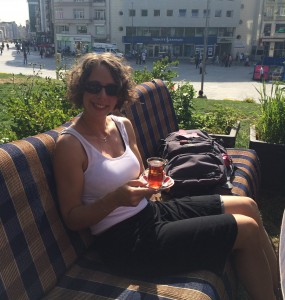 Beyoğlu is essentially the main street, particularly for shopping. It has a really old tram that runs up and down the length of the street up to Taksim Square. Apparently the tram ride is absolutely worth a ride, but I didn’t do it myself.
Beyoğlu is essentially the main street, particularly for shopping. It has a really old tram that runs up and down the length of the street up to Taksim Square. Apparently the tram ride is absolutely worth a ride, but I didn’t do it myself.
I spent a leisurely day walking up, and then back down the entire shopping street, enjoying some shopping along the way. Once I got to Taksim Square at the top of the hill I found a nice park to sit and enjoy a cup of tea.
Spice Market
The Spice Market, down towards the river area, was quite disappointing. There were many stores with beautiful displays selling wonderful smelling, colourful spices, natural teas and more types of Turkish delight than you thought existed. But there were just as many souvenir stores as there were tea and spice stores. Also they were stores in a big market hall, where I had anticipated more a market style set up. It is definitely worth a visit, but don’t expect it to be only spices and teas.
Grand Bazaar
The Grand Bazaar is also a huge market hall with stores, only on a massive scale with many different winding paths throughout. I imagine it would be very easy to get lost in the labyrinth of paths.
There were of course a huge number of souvenir stores in the Grand Bazaar, as well as clothing and shoe stores.
One of the items I have seen many times and consider beautiful, though I would never buy any, are the glass mosaic hanging lamps. So many beautiful colours and patterns!
Food and Drink
Turkish tea, black tea and apple tea, is a popular drink. You will see many little cafés around town, you even see groups of policemen taking time out from their duties to sit and enjoy a cuppa.
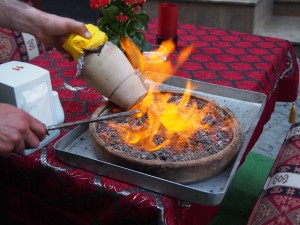 Turkish Coffee is also very popular, but I would have to say that I am not a fan. It is very strong, in a very small cup and basically half of it is coffee grind sludge.
Turkish Coffee is also very popular, but I would have to say that I am not a fan. It is very strong, in a very small cup and basically half of it is coffee grind sludge.
A food that I would highly recommend trying is the Testi Kebab. It’s a meat stew with tomato, capsicum and other bits and pieces. It is slow cooked for a few hours in a ceramic jar. Then when you are ready to eat, the last bit of the cooking is done near your table. A tray of salt is lit and in the flames the jar is rotated until it is ‘just right’. Then they turn it upside down and smash the base off the jar, before pouring the contents into a warmed tray to serve. It was so fun to watch and it was certainly one of the tastiest dishes I ate in my entire visit to Turkey.
Cooking Class
 We did a cooking class in Istanbul, I always find it’s a good way to learn a bit more about the culture of a country. This class was run from the kitchen of the Arena Hotel, we had a hotel office staff member working as a translator and two chefs.
We did a cooking class in Istanbul, I always find it’s a good way to learn a bit more about the culture of a country. This class was run from the kitchen of the Arena Hotel, we had a hotel office staff member working as a translator and two chefs.
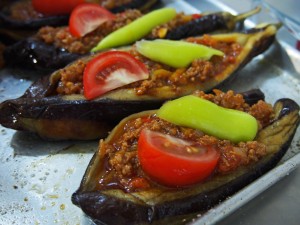 Together we cooked the dishes for one meal (but the quantity for 10 people!). We started with Mercimek Corbasi which is a red lentil soup. The main dish that we made was Karnivak, Aubergines stuffed with a meat and tomato mix. This was served with rice and vermicelli noodles combined (most of the time you are served rice, it contains a second ingredient, like small pasta noodle or another type of grain). The side dish we prepared was Cacik which is a yoghurt, cucumber and mint dip. It was all delicious!!!!
Together we cooked the dishes for one meal (but the quantity for 10 people!). We started with Mercimek Corbasi which is a red lentil soup. The main dish that we made was Karnivak, Aubergines stuffed with a meat and tomato mix. This was served with rice and vermicelli noodles combined (most of the time you are served rice, it contains a second ingredient, like small pasta noodle or another type of grain). The side dish we prepared was Cacik which is a yoghurt, cucumber and mint dip. It was all delicious!!!!
Cappadocia
Cappadocia is not a town, rather a large region somewhere in the middle of Turkey. The region is volcanic, though the last eruption was 5 million years ago. The many eruptions over time deposited layers of ash on the ground, which built up to become mountains. Over time the wind and rain has eroded these layered mountain of ash to create some amazing and interesting rock formations.
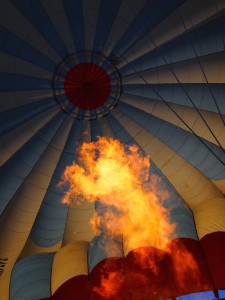 The one absolute must-do thing in Cappadocia is to go hot air ballooning over the valleys. It is phenomenal! There are two flight times each day. The first time is for sunrise (hotel pickup is at about 4am) and approximately 100 balloons are allowed to fly. The second flight of the day is still ridiculously early, hotel pickup around 5am, and approximately 85 balloons are allowed to fly. We had the second flight of the morning, the air was crisp but clear, and the view of all the balloons in the air as we waited for our balloon to be filled with air, was just breath taking.
The one absolute must-do thing in Cappadocia is to go hot air ballooning over the valleys. It is phenomenal! There are two flight times each day. The first time is for sunrise (hotel pickup is at about 4am) and approximately 100 balloons are allowed to fly. The second flight of the day is still ridiculously early, hotel pickup around 5am, and approximately 85 balloons are allowed to fly. We had the second flight of the morning, the air was crisp but clear, and the view of all the balloons in the air as we waited for our balloon to be filled with air, was just breath taking.
 Our pilot Gülsah was one of only five female pilots of over 100 in the region, she took us low into the valleys as well as up to 6000 feet. She navigated us safely around mountains and avoided other balloons. It was so calming to be in the balloon, floating with the wind and taking in some of the most amazing views you could imagine. It’s another of those activities that is just so fantastic it is hard to put into words.
Our pilot Gülsah was one of only five female pilots of over 100 in the region, she took us low into the valleys as well as up to 6000 feet. She navigated us safely around mountains and avoided other balloons. It was so calming to be in the balloon, floating with the wind and taking in some of the most amazing views you could imagine. It’s another of those activities that is just so fantastic it is hard to put into words.
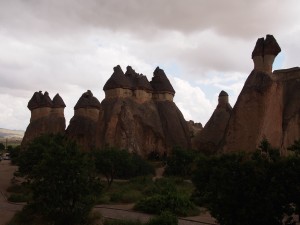 Throughout the region you can find many valleys, mountains, caves and fairy chimneys. Fairy chimneys are mostly found around the town of Göreme. They are typically tall thin rock formations that appear to have a hat on them, kind of mushroom like. In some places the chimneys aren’t singly single formations, but clustered. They say that it was unknown how the chimneys got their ‘hats’ and that it must have been fairy’s that made them, which is how they got the name Fairy Chimneys. The appearance of the hats or mushroom tops of the chimneys is more likely caused by wind erosion. The wind must blow tear through the valleys but only go up to a certain height, which I find odd and a little hard to believe, but it’s otherwise a little hard to imagine hot the chimneys got their tops. No matter what the cause, the fairy chimneys look very cool.
Throughout the region you can find many valleys, mountains, caves and fairy chimneys. Fairy chimneys are mostly found around the town of Göreme. They are typically tall thin rock formations that appear to have a hat on them, kind of mushroom like. In some places the chimneys aren’t singly single formations, but clustered. They say that it was unknown how the chimneys got their ‘hats’ and that it must have been fairy’s that made them, which is how they got the name Fairy Chimneys. The appearance of the hats or mushroom tops of the chimneys is more likely caused by wind erosion. The wind must blow tear through the valleys but only go up to a certain height, which I find odd and a little hard to believe, but it’s otherwise a little hard to imagine hot the chimneys got their tops. No matter what the cause, the fairy chimneys look very cool.
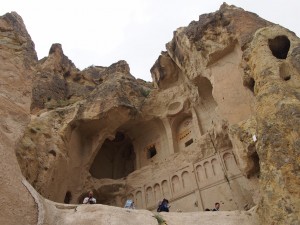 In Göreme is also an open air museum which shows many of the cave dwellings and churches. It’s a great spot to visit as you get to look at the constructions of the cave dwellings at close quarters. Get a feel for how they lived and you can even see a lot of original art works.
In Göreme is also an open air museum which shows many of the cave dwellings and churches. It’s a great spot to visit as you get to look at the constructions of the cave dwellings at close quarters. Get a feel for how they lived and you can even see a lot of original art works.
While the rock formations in Cappadocia are all natural, their conversion to caves is absolutely the result of humans. Some cave dwellings are still privately owned, if they aren’t in a national park people may even still live in them.
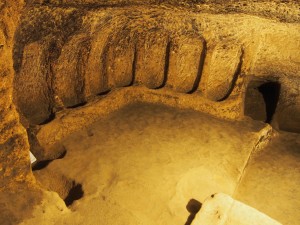 Back in the time of the Hittites, underground cities were created as places to hide from the enemies. Seeking refuge in an underground city was always a temporary option, but in some cases people lived in the cities for up to a year. The cities have many levels and an endless stream of tunnels. I was incredibly impressed to find a winery in one of the cities!!
Back in the time of the Hittites, underground cities were created as places to hide from the enemies. Seeking refuge in an underground city was always a temporary option, but in some cases people lived in the cities for up to a year. The cities have many levels and an endless stream of tunnels. I was incredibly impressed to find a winery in one of the cities!!
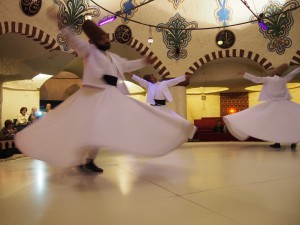 We interrupted all our visits to rock formations with an evening show. We went to see the Whirling Dervishes. The Sufis whirl around in circles as a form of meditation, in which they feel a connection between their god and the earth. as they spin they reach their arms up, the right hand higher than the left and their head tilted to the right. The right hand is their connection to god and their left is their connection to earth. The whirling ceremony is led by a Sheikh and is made up of seven parts, including singing, bowing to each other, four sets of twirling and a reading from the Qu’ran. I found it quite an interesting ceremony to watch. If you come to Turkey, make sure you see a ceremony.
We interrupted all our visits to rock formations with an evening show. We went to see the Whirling Dervishes. The Sufis whirl around in circles as a form of meditation, in which they feel a connection between their god and the earth. as they spin they reach their arms up, the right hand higher than the left and their head tilted to the right. The right hand is their connection to god and their left is their connection to earth. The whirling ceremony is led by a Sheikh and is made up of seven parts, including singing, bowing to each other, four sets of twirling and a reading from the Qu’ran. I found it quite an interesting ceremony to watch. If you come to Turkey, make sure you see a ceremony.
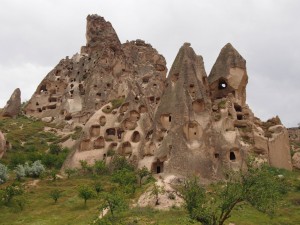 During our time in Cappadocia the weather was a bit up and down, we had some moments of brilliant sunshine and other moments of thunder and hail storms. We still got to see a great deal of the area, including visits to Uchisar Castle, the Rose Valley, Pigeon Valley and the Red Valley. At one point on a rainy afternoon, we also managed to fit in a wine tasting of some local wines. An absolute bonus and high point of our visit to Cappadocia was staying in a cave hotel (MDC Hotel) which was just amazing!
During our time in Cappadocia the weather was a bit up and down, we had some moments of brilliant sunshine and other moments of thunder and hail storms. We still got to see a great deal of the area, including visits to Uchisar Castle, the Rose Valley, Pigeon Valley and the Red Valley. At one point on a rainy afternoon, we also managed to fit in a wine tasting of some local wines. An absolute bonus and high point of our visit to Cappadocia was staying in a cave hotel (MDC Hotel) which was just amazing!

Everywhere you look in Cappadocia there are amazing things to see. Anyone considering a trip to Turkey must make time to visit!
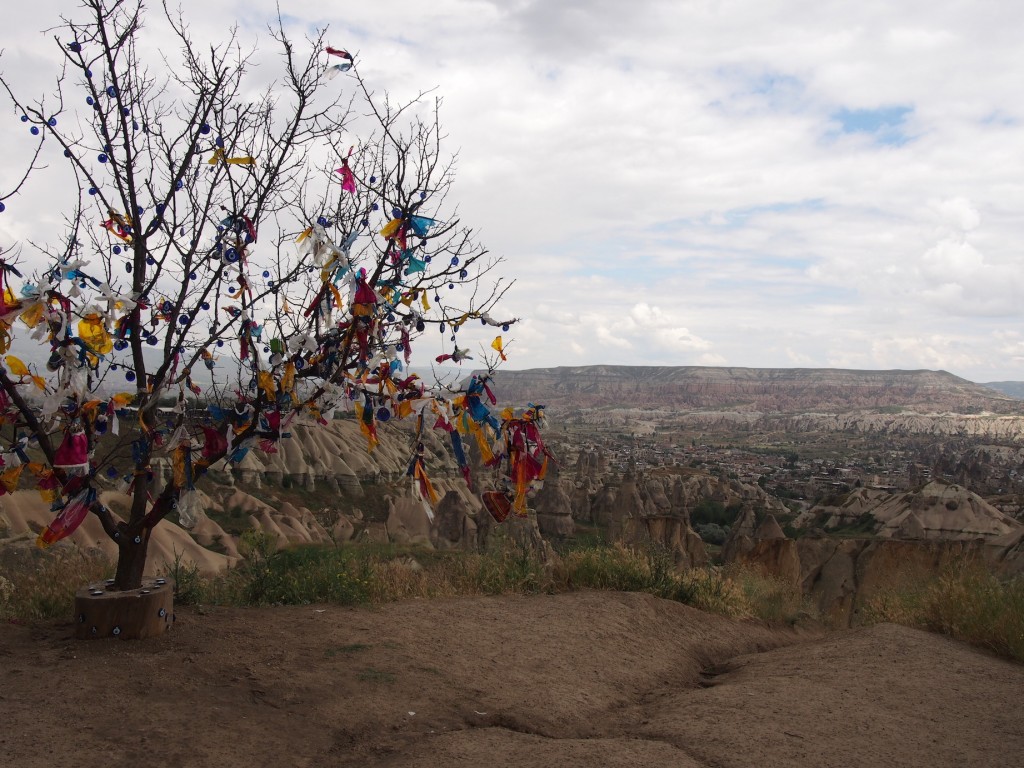 For all my Cappadocia photos, check out the album on Flickr.
For all my Cappadocia photos, check out the album on Flickr.
Ephesus and Pamukkale
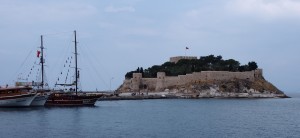 Turkey is quite a big country within Europe, with a population close to 80 million. 18 million of whom live in Istanbul, which despite its popularity is not the capital of Turkey. Turkey is quite odd because it spans two different continents. 3% of Turkey is in Europe, a region referred to as Thrace and 97% is in Asia, referred to as Anatolia.
Turkey is quite a big country within Europe, with a population close to 80 million. 18 million of whom live in Istanbul, which despite its popularity is not the capital of Turkey. Turkey is quite odd because it spans two different continents. 3% of Turkey is in Europe, a region referred to as Thrace and 97% is in Asia, referred to as Anatolia.
For me personally Turkey had three main destinations I wanted to visit: Istanbul, Pamukkale and Cappadocia. I will talk about Cappadocia and Istanbul in coming posts, but for now I would like to talk about the coastal town Kusadasi and its nearby highlights.
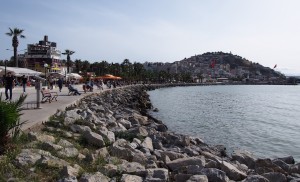 Kusadasi
Kusadasi
Kusadasi is a major tourist port on the coast of the Aegean Sea. It regularly has multiple cruise ships in port. Because of this the town is incredibly touristy, very expensive and for me, it wasn’t that pleasant a place to be. The major draw card of Kusadasi is its proximity to some other places.
The House of the Virgin Mary
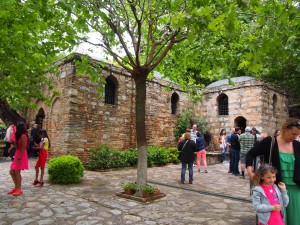 In the 19th century a Roman Catholic nun, Blessed Anne Catherine Emmerich had visions of the house of the Virgin Mary, describing its location and its appearance. The visions were recorded author Clemens Brentano. Some time later a French priest discovered a house near the Aegean Sea that matched the exact description Mary’s house as recorded by Brentano. Despite the question of authenticity, many people make the pilgrimage to the house. Many people also take the water from the natural springs nearby to use as holy water, with the belief it has some spiritual and healing properties. There is also a wishing wall where people write their wish on a piece of paper and tie it to the wishing wall. It was quite an interesting site to visit, and it certainly has a great deal of history.
In the 19th century a Roman Catholic nun, Blessed Anne Catherine Emmerich had visions of the house of the Virgin Mary, describing its location and its appearance. The visions were recorded author Clemens Brentano. Some time later a French priest discovered a house near the Aegean Sea that matched the exact description Mary’s house as recorded by Brentano. Despite the question of authenticity, many people make the pilgrimage to the house. Many people also take the water from the natural springs nearby to use as holy water, with the belief it has some spiritual and healing properties. There is also a wishing wall where people write their wish on a piece of paper and tie it to the wishing wall. It was quite an interesting site to visit, and it certainly has a great deal of history.
Ephesus
 Near to the House of the Virgin Mary is the ancient city of Ephesus. It was built around 6000BC and experienced many different regimes throughout its existence. When looking at the architecture and construction these regimes are visible. As an example, the red brickwork is from the Byzantine period; marble from the Roman period and grey stone from the Greek period.
Near to the House of the Virgin Mary is the ancient city of Ephesus. It was built around 6000BC and experienced many different regimes throughout its existence. When looking at the architecture and construction these regimes are visible. As an example, the red brickwork is from the Byzantine period; marble from the Roman period and grey stone from the Greek period.
I’m not the most knowledgeable on history, but I must say it was a very old site and while I might not have retained must of the history I was provided, I did find it a fascinating place.
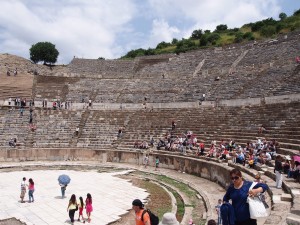 The city was enormous and very spread out. I think that without deviating much from the main path, it was over a kilometer walking from one end to the other. There were two amphitheaters, the smaller one up the hill and the larger towards the bottom of the site. The larger one was used for bigger events, including gladiator and animal fights. Nearby this amphitheater was the gymnasium, where the gladiators trained in fitness, strength and fighting skills.
The city was enormous and very spread out. I think that without deviating much from the main path, it was over a kilometer walking from one end to the other. There were two amphitheaters, the smaller one up the hill and the larger towards the bottom of the site. The larger one was used for bigger events, including gladiator and animal fights. Nearby this amphitheater was the gymnasium, where the gladiators trained in fitness, strength and fighting skills.
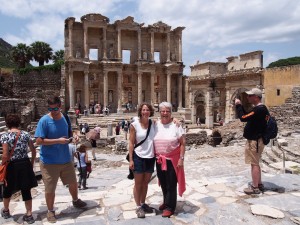 Based on the size of the amphitheater, and other factors I’m sure, archeologists have determined that the ancient city had a population of roughly 250,000. Of those 200,000 were locals and 50,000 were slaves. My two favourite structures in the city were the temple of Hadrian and the Library; they are both gorgeous structures and have lots of fine detail in the carvings.
Based on the size of the amphitheater, and other factors I’m sure, archeologists have determined that the ancient city had a population of roughly 250,000. Of those 200,000 were locals and 50,000 were slaves. My two favourite structures in the city were the temple of Hadrian and the Library; they are both gorgeous structures and have lots of fine detail in the carvings.
Temple of Artemis
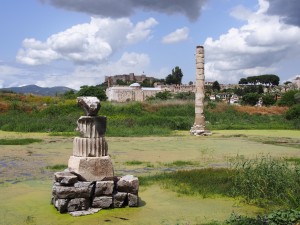 The goddess Artemis was considered the goddess of fertility in Roman times. A temple was created and dedicated to her, the Temple of Artemis, which is one of the Seven Wonders of the Ancient World.
The goddess Artemis was considered the goddess of fertility in Roman times. A temple was created and dedicated to her, the Temple of Artemis, which is one of the Seven Wonders of the Ancient World.
It was originally a grand structure with 127 columns, but now only one remains together with some small parts of the foundations.
Pamukkale
 The name Pamukkale translates to Cotton Castle. The region got this name because of the high volume of calcium carbonate in the water, which has created a white ‘castle’ on the hillside, with hot springs and travertines. The castle used to be pristine white, but due to its popularity many people used to visit, hotels were built on the site, people used to walk on the area and even ride motorbikes over the area. Thankfully UNESCO has since protected it and site access is fairly heavily restricted. If you want to walk down to the travertines and swim in the small pools you must walk barefoot.
The name Pamukkale translates to Cotton Castle. The region got this name because of the high volume of calcium carbonate in the water, which has created a white ‘castle’ on the hillside, with hot springs and travertines. The castle used to be pristine white, but due to its popularity many people used to visit, hotels were built on the site, people used to walk on the area and even ride motorbikes over the area. Thankfully UNESCO has since protected it and site access is fairly heavily restricted. If you want to walk down to the travertines and swim in the small pools you must walk barefoot.
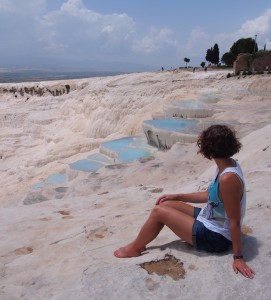 The ancient city of Hierapolis was actually built on the hillside above the castle, and many opt to visit this city as well as the white castle. For me, the only thing that had my attention was the travertines. The white castle covers a large area and is approximately 2,700 metres long, 600 metres wide and 160 metres high. Of this, most of the travertines are dried up, but there is one very small portion that remains. Small, tiered, pristine white terraces containing vivid aqua-blue water that are just stunning to see. Battling the hordes of tourists was worth it to see this amazing natural wonder.
The ancient city of Hierapolis was actually built on the hillside above the castle, and many opt to visit this city as well as the white castle. For me, the only thing that had my attention was the travertines. The white castle covers a large area and is approximately 2,700 metres long, 600 metres wide and 160 metres high. Of this, most of the travertines are dried up, but there is one very small portion that remains. Small, tiered, pristine white terraces containing vivid aqua-blue water that are just stunning to see. Battling the hordes of tourists was worth it to see this amazing natural wonder.
Rio de Janeiro
Rio de Janeiro is another one of those big cities that has a lot to offer. It has a population of over 6 million and has amazing scenery. It is on the coast of Brazil and has many beaches and mountains.
Cristo Redentor
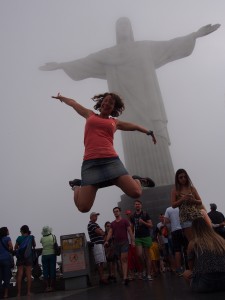 Christ the Redeemer is the world’s biggest Art Deco structure. It is a beautifully crafted structure, made of soapstone. It stands 710 meters above sea level on the peak known as Corcovado. The structure itself is 30 metres high, with an arm span of 28 meters. In 2007 the statue was voted one of the new Seven Wonders of the World.
Christ the Redeemer is the world’s biggest Art Deco structure. It is a beautifully crafted structure, made of soapstone. It stands 710 meters above sea level on the peak known as Corcovado. The structure itself is 30 metres high, with an arm span of 28 meters. In 2007 the statue was voted one of the new Seven Wonders of the World.
While it wasn’t as big as I had expected it to be, it was just as amazing as I had anticipated. I had so much fun taking photos of it, but also the view from Corcovado is almost as good as the statue itself.
Visiting in low season, the ticket cost was R$24 and included the mini bus ride to the peak.
Esacadaria Selarón (Selarón’s stairs)
Eccentric Chilean artist Jorge Selarón was living in the area of Lapa and there was a staircase he walked regularly, but he found it boring. One day he began to decorate the face of each step with mosaic tiles. Once he had tiled the face of each step, he began to do the walls as well. Once the entire staircase was done, he would start to work his way back through each step and renew the design. This started to attract attention and soon travellers from all over the world were giving him tiles to use in his designs.
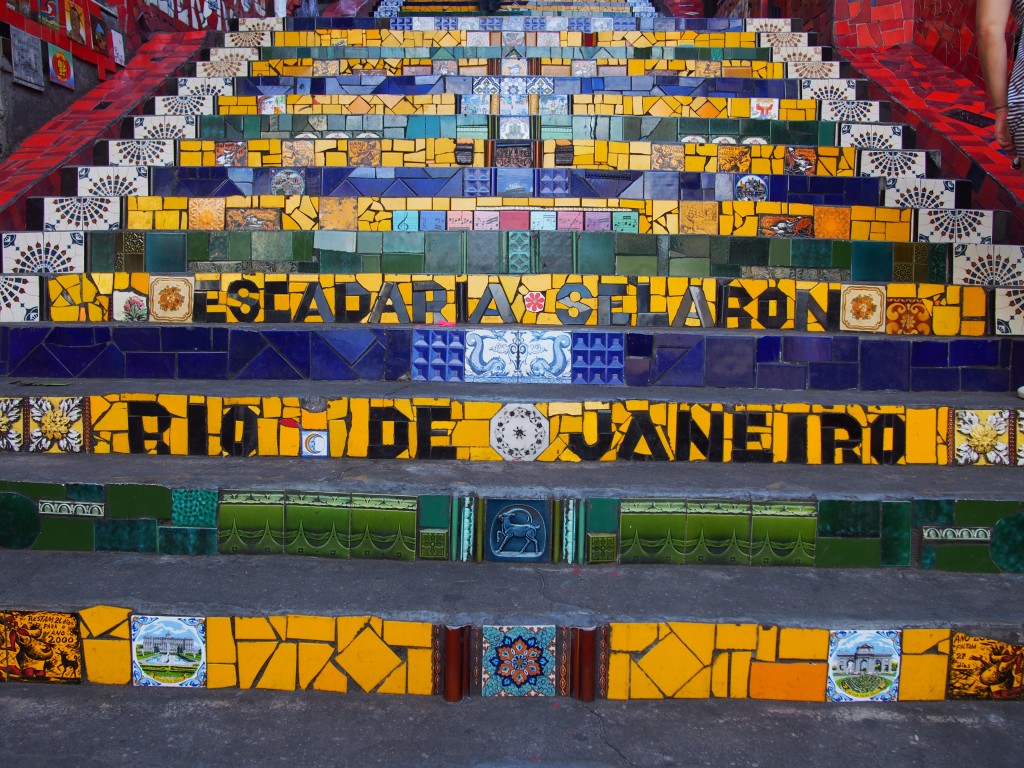 When you stand at the bottom of the staircase and look up, it is an amazing colourful mixture on tiles from different countries and it looks fabulous.
When you stand at the bottom of the staircase and look up, it is an amazing colourful mixture on tiles from different countries and it looks fabulous.
In 2012 Jorge’s body was found at the base of the stairs under mysterious circumstances. The official ruling is that it was suicide, but there remain many people who believe he was assassinated. The staircase remains untouched in the last design that he created and is a very popular spot for the tourists to visit.
This is a free activity.
Pão de Açúcar
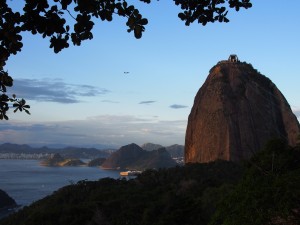 Sugarloaf mountain is a Rio icon, a 396m mountain that provides fabulous views of the city. To get to the top you catch a cable car. The cable car first takes you to Morro da Urca, where there are some viewing platforms. From there you ride another cable car to the top of Pão de Açúcar. One of the cable cars is quite old, and it has been retained because it is famous for having been used in the James Bond film Moonraker.
Sugarloaf mountain is a Rio icon, a 396m mountain that provides fabulous views of the city. To get to the top you catch a cable car. The cable car first takes you to Morro da Urca, where there are some viewing platforms. From there you ride another cable car to the top of Pão de Açúcar. One of the cable cars is quite old, and it has been retained because it is famous for having been used in the James Bond film Moonraker.
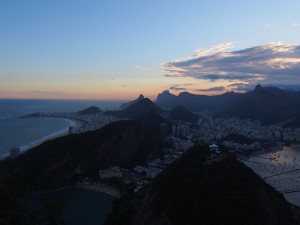 The cable car ride is quite fun, but the views are simply amazing! You can see the city, a number of the beaches and in the distance, Christ on the hill.
The cable car ride is quite fun, but the views are simply amazing! You can see the city, a number of the beaches and in the distance, Christ on the hill.
This activity cost R$62.
Favela’s
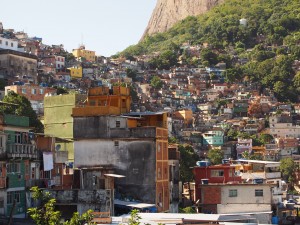 A favela is essentially a slum. They were originally created by soldiers using bits and pieces of whatever materials they could find. Because they weren’t official structures, the people were able to live without having to pay taxes. This also meant though, that they didn’t have access to proper infrastructure. These days most favelas have running water and electricity (electricity is not always by legal means), however there is no sewerage systems and the sewerage runs through the streets. Many favelas were previously, and some still are, ‘governed’ by drug lords. They regularly experience violence and various types of crimes. A favela is certainly not a place you want to go by yourself.
A favela is essentially a slum. They were originally created by soldiers using bits and pieces of whatever materials they could find. Because they weren’t official structures, the people were able to live without having to pay taxes. This also meant though, that they didn’t have access to proper infrastructure. These days most favelas have running water and electricity (electricity is not always by legal means), however there is no sewerage systems and the sewerage runs through the streets. Many favelas were previously, and some still are, ‘governed’ by drug lords. They regularly experience violence and various types of crimes. A favela is certainly not a place you want to go by yourself.
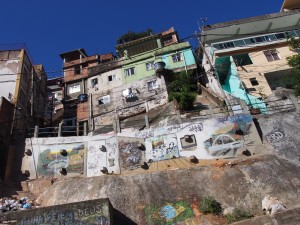 A group of us did a favela tour and visited two ‘safe’ Favelas: Rocinha and Vila Canoas.
A group of us did a favela tour and visited two ‘safe’ Favelas: Rocinha and Vila Canoas.
Rocinha is in Rio’s south zone and it the biggest Favela in Rio. It was built on s steep hillside and looks down over the city of Rio. According to census data it has a population of 75,000 but they actually suspect it is closer to 200,000. We didn’t really walk through the favela, mostly we saw it from the outskirts. We did walk through a short section just at the bottom, and despite the warnings of violence and criminals, everyone I walked past smiled and welcomed us to Rocinha.
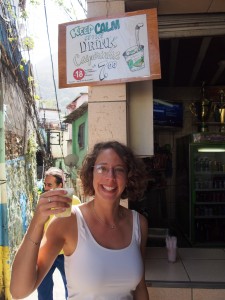 Vila Canoas is another favela, but smaller. Vila Canoas is a more developed and has never been run by gangs. Here we visited a local school, which is strongly supported through the money made from favela tours – so it was good for us to see where some of our money was going. We spent some time wandering through the narrow alleyways of Vila Canoas. Compared to my expectations it was quite clean, but it was such a crazy maze or tiny alleyways and stairwells. It was also easy to see the construction style, how everything was made from bits and pieces and painted different colours. It was really interesting to see.
Vila Canoas is another favela, but smaller. Vila Canoas is a more developed and has never been run by gangs. Here we visited a local school, which is strongly supported through the money made from favela tours – so it was good for us to see where some of our money was going. We spent some time wandering through the narrow alleyways of Vila Canoas. Compared to my expectations it was quite clean, but it was such a crazy maze or tiny alleyways and stairwells. It was also easy to see the construction style, how everything was made from bits and pieces and painted different colours. It was really interesting to see.
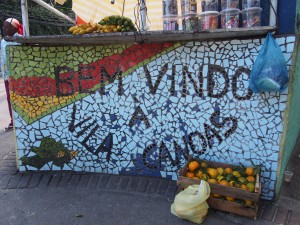 We also supported local people living in the favelas by buying handicrafts and drinks.
We also supported local people living in the favelas by buying handicrafts and drinks.
The Favela tour cost R$100, in my opinion it a must-see!
Hang gliding
An activity I would consider a ‘must do’ in Rio is hang gliding. A number of companies offer it, I used a company called Delta Fly because there was a brochure of theirs in my hotel lobby.
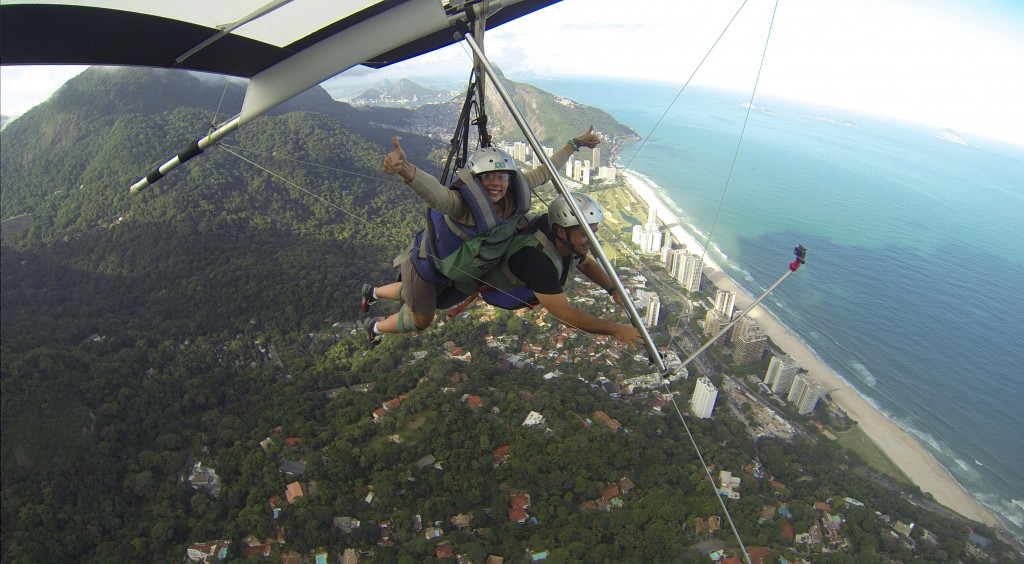 You launch at 510 metres above sea level from a giant granite mountain called Pedra Bonita. (You can also go paragliding, but the last time I was attached to a parachute I experienced really bad motion sickness, so in this case I opted for hang gliding).
You launch at 510 metres above sea level from a giant granite mountain called Pedra Bonita. (You can also go paragliding, but the last time I was attached to a parachute I experienced really bad motion sickness, so in this case I opted for hang gliding).
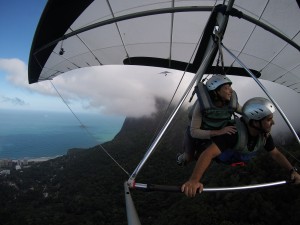 At the top of the mountain I received a 3 minute briefing on what I needed to do. Before I knew it, I was running down a ramp and launching myself into the sky (with my ‘pilot’ of course). I found it such a peaceful feeling, to be floating in the sky. It was so calm. The flight time is dependent on the wind of course, and I was lucky to have a solid 20 minute flight. The view of Rio from the sky is indescribably beautiful. I got fantastic views of the city, the beaches and the mountains. The only thing there wasn’t a great view of was Christ the Redeemer, but that wasn’t a big deal.
At the top of the mountain I received a 3 minute briefing on what I needed to do. Before I knew it, I was running down a ramp and launching myself into the sky (with my ‘pilot’ of course). I found it such a peaceful feeling, to be floating in the sky. It was so calm. The flight time is dependent on the wind of course, and I was lucky to have a solid 20 minute flight. The view of Rio from the sky is indescribably beautiful. I got fantastic views of the city, the beaches and the mountains. The only thing there wasn’t a great view of was Christ the Redeemer, but that wasn’t a big deal.
This activity cost R$400 for the hang gliding R$30 for the insurance and the disc of photos and videos from the side camera and front camera cost R$130 (because we went with a small group of us, we were able to negotiate R$130 rather than the originally quoted price of R$150)
Samba show
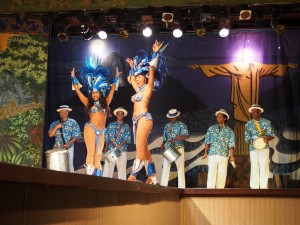 A group of us booked ourselves into a samba show and dinner, despite having read bad reviews online. We felt that no trip to Rio would be complete without seeing a samba show.
A group of us booked ourselves into a samba show and dinner, despite having read bad reviews online. We felt that no trip to Rio would be complete without seeing a samba show.
The costumes were flamboyant, colourful and ridiculously skimpy. I’m not convinced that the dancing was a traditional samba but it certainly was entertaining, tacky and over the top.
I will say though, how impressed I was at the amount of booty control the women had when they were shaking their ‘thang’.
The dinner and show cost R$220, and even though it wasn’t high quality by any means, it was entertaining and worth the time and money.
Santa Teresa
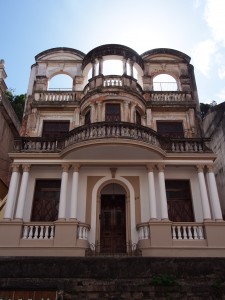 Santa Teresa is a suburb of Rio, on a hill overlooking the city. It is a cute suburb with cobbled streets, ageing mansions and great deal of history. These days it has a bohemian feel. There are cute cafés and many souvenir stores displaying colourful and creative artworks from local artists. Santa Teresa is also a great spot to go hunting for awesome street art.
Santa Teresa is a suburb of Rio, on a hill overlooking the city. It is a cute suburb with cobbled streets, ageing mansions and great deal of history. These days it has a bohemian feel. There are cute cafés and many souvenir stores displaying colourful and creative artworks from local artists. Santa Teresa is also a great spot to go hunting for awesome street art.
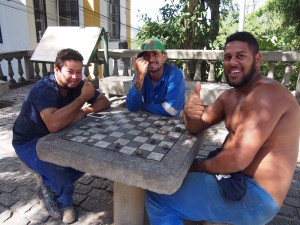 For R$20 each, a local guide gave a group of us a walking tour of Santa Teresa. It was a very pleasant 1.5 – 2 hour walking tour, the guide was very knowledgeable and the whole suburb was simply lovely to explore.
For R$20 each, a local guide gave a group of us a walking tour of Santa Teresa. It was a very pleasant 1.5 – 2 hour walking tour, the guide was very knowledgeable and the whole suburb was simply lovely to explore.
Copacabana beach & night markets
Copacabana is one of Rio’s most famous beaches. It stretches 4.5km from end to end. While I didn’t make it, the sunset from the end of Copacabana beach, where it meets Ipanema beach, is said to be stunning.
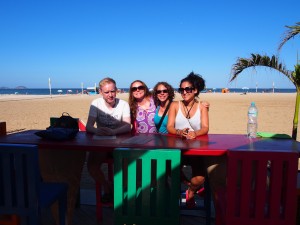 Copacabana is lined with little cafés selling cheap food and drinks. The beach itself also has many little stalls and wandering vendors selling drinks, hats, bikinis, and much more.
Copacabana is lined with little cafés selling cheap food and drinks. The beach itself also has many little stalls and wandering vendors selling drinks, hats, bikinis, and much more.
The beach is a great spot to sit and soak up the sun while enjoying a cheap cocktail, but you do need to be very cautious with your belongings. Avoid taking valuables to the beach with you. Keep your eye, and preferably a hand, on your belongings at all times. If you go swimming, either tag team with a buddy or find someone to look after your stuff. Thankfully I didn’t have any problems with thieves, but we were warned countless times by various people to be careful.
 At night the beach is not the safest place to be, and you are advised to remain in well-lit areas. One well-lit area I would recommend visiting is the pavement between the two lanes of road, in this stretch is a daily market with loads of fun and cheap souvenirs. It starts some time after the sun has set and closes at 10:30pm.
At night the beach is not the safest place to be, and you are advised to remain in well-lit areas. One well-lit area I would recommend visiting is the pavement between the two lanes of road, in this stretch is a daily market with loads of fun and cheap souvenirs. It starts some time after the sun has set and closes at 10:30pm.
Rio was the final destination of my Intrepid Tour, Buenos Aires to Rio Unplugged. I had an absolute blast, made great friends and had amazing experiences. The travel guide Fede was brilliant, informative and helpful with organising any extras.
So for now, I am saying goodbye South America, I hope to visit again soon.
 Check out all my Rio De Janeiro photos on Flickr.
Check out all my Rio De Janeiro photos on Flickr.
Paraty & Ilha Grande
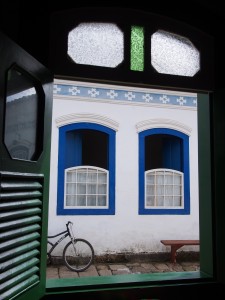 Paraty
Paraty
Paraty, on the coast of Brazil, used to be the capital of Brazil. It has a deep and calm harbour, well protected by several islands. Unfortunately these islands served as an ideal hiding place for pirates and much gold was lost. After some time the capital was moved to Río De Janeiro.
 Paraty is another UNESCO protected town. The old part of town is one of the cutest places I have ever seen. All the buildings are covered in a white render, but the doorways, doors, window frames and shutters are all different colours. It’s absolutely beautiful to see. A number of the buildings also have cute or quirky features, like interesting lights, decorative features on the verandah railings, bizarre door knockers or painted decorative features on the building corners.
Paraty is another UNESCO protected town. The old part of town is one of the cutest places I have ever seen. All the buildings are covered in a white render, but the doorways, doors, window frames and shutters are all different colours. It’s absolutely beautiful to see. A number of the buildings also have cute or quirky features, like interesting lights, decorative features on the verandah railings, bizarre door knockers or painted decorative features on the building corners.
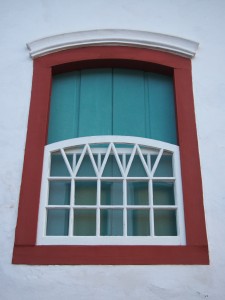 A great way to spend the time in Paraty is just to wander the narrow cobblestone streets of the old town absorbing the gorgeous buildings, colours and checking out handicrafts.
A great way to spend the time in Paraty is just to wander the narrow cobblestone streets of the old town absorbing the gorgeous buildings, colours and checking out handicrafts.
The town is on the coast, so it’s also lovely to stroll by the ocean and enjoy a drink on the beach.
Ihla Grande
Ihla Grande, Big Island, is off the coast of Rio De Janeiro. It is 193 m2 and is a popular tourist destination because of it’s scenery and chilled beaches. We enjoyed three nights on the island. The main town is Vila do Abraão and offers many hotels, hostels, restaurants and little shops to visit. The island doesn’t offer a great variety of activities as such, as they are all based around hiking and swimming, but those things are fabulous to do on the island.
Pico de Papagaio (Parrot’s Peak)
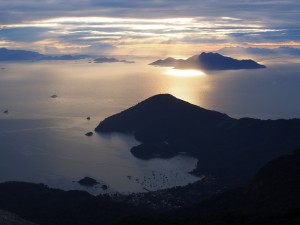 The hike up to parrots peak to the elevation of 982 metres, is quite a challenging one, particularly when you choose to do the sunrise hike. We met our guide Guillermo Farabollini at 2:30am in the town centre. He cut us some bamboo walking poles with his machete and off we went. We trekked up some crazy narrow, steep and slippery jungle path lit only by the light beams of our head torches. Throughout the hike we did also manage to spot some wildlife including a tarantula, snake (awesome black and orange striped tree snake) and some black howler monkeys. The hike is roughly 13km return from town. Even at 2:30 in the morning it is a hot and grueling hike. We made a few stops along the way to drink water and eat bananas.
The hike up to parrots peak to the elevation of 982 metres, is quite a challenging one, particularly when you choose to do the sunrise hike. We met our guide Guillermo Farabollini at 2:30am in the town centre. He cut us some bamboo walking poles with his machete and off we went. We trekked up some crazy narrow, steep and slippery jungle path lit only by the light beams of our head torches. Throughout the hike we did also manage to spot some wildlife including a tarantula, snake (awesome black and orange striped tree snake) and some black howler monkeys. The hike is roughly 13km return from town. Even at 2:30 in the morning it is a hot and grueling hike. We made a few stops along the way to drink water and eat bananas.
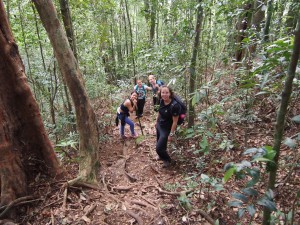 We made it to the peak just as the sun started to peek out from behind the mountains and clouds. It was such an amazing view and absolutely worth the torture of such an epic morning hike. We spent between 30 to 60 minutes sitting at the peak, absorbing the amazing views. We could see the main town on the island, the popular beach Lopes Mendes and you could even almost see Rio de Janeiro in the distance. Once the sun rose, we also found out that we had a second guide, a local dog. The local dogs take it in shifts, each one accompanying a tour group up and down the mountain for their hike. It’s adorable!!
We made it to the peak just as the sun started to peek out from behind the mountains and clouds. It was such an amazing view and absolutely worth the torture of such an epic morning hike. We spent between 30 to 60 minutes sitting at the peak, absorbing the amazing views. We could see the main town on the island, the popular beach Lopes Mendes and you could even almost see Rio de Janeiro in the distance. Once the sun rose, we also found out that we had a second guide, a local dog. The local dogs take it in shifts, each one accompanying a tour group up and down the mountain for their hike. It’s adorable!!
The hike back down was also quite challenging, but interesting to see where you had been and what you had missed along the way without daylight. It was a hard, but great hike. An activity I would recommend doing, and call Guillermo because he’s a great guide. He speaks English really well, is passionate about what he does and knows loads about the animals in the area.
Lopes Mendes Beach
Lopes Mendes beach is one of the top ten beaches in Brazil and it is a beach of very fine white sand, with a sweeping curve a few kilometres long. You can get there one of two ways, it’s approximately a two hour hike from the main town, or you can catch a water taxi which takes about 15-20 minutes. With a group of us we paid R$40 each, which I consider quite reasonable. If you take the boat, it’s still a 20-minute hike to get to Lopes Mendes from the drop off point.
Being from Tasmania, Australia where the beaches are pure, clean and uncrowded, I’m quite the beach snob. Despite my beach snobbery, I found Lopes Mendes to be a lovely beach, relaxing, clean and super chilled out. There weren’t any vendors hassling you to buy things. It was just a location purely for relaxing and I loved it!
Boat tours around the Island
Another popular activity is to join in a boat cruise around the island. You can opt for a 7 hour trip the whole way around the island or the shorter 4 hour trip ‘half way’ round the island. As a tour group we hired a speed boat for ourselves to do the half island trip and it was worth every penny!
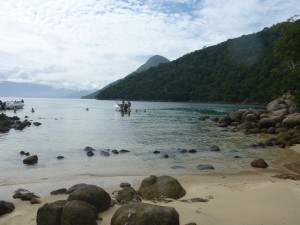 We hired a 14 person boat, we bought all our snacks and drinks, stocked the boat eski and off we went. We first whizzed around to our furthest most destination, Lagoa Verde (Green Lagoon). It offered some gorgeous, clear green/blue water in which to snorkel. The green colour of the lagoon is partly from the green coral I believe. There were heaps of gorgeous multi coloured fish here, and it was a brilliant spot to stop and soak up the sun and the snorkeling.
We hired a 14 person boat, we bought all our snacks and drinks, stocked the boat eski and off we went. We first whizzed around to our furthest most destination, Lagoa Verde (Green Lagoon). It offered some gorgeous, clear green/blue water in which to snorkel. The green colour of the lagoon is partly from the green coral I believe. There were heaps of gorgeous multi coloured fish here, and it was a brilliant spot to stop and soak up the sun and the snorkeling.
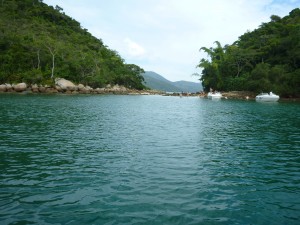 The second stop was Lagoa Azul (Blue Lagoon), which was another fabulous spot to stop. Green Lagoon seemed like a bay, but Blue Lagoon seemed more like a lagoon set in between various little islands. There was less coral here and fewer fish, but it was nonetheless a fabulous location.
The second stop was Lagoa Azul (Blue Lagoon), which was another fabulous spot to stop. Green Lagoon seemed like a bay, but Blue Lagoon seemed more like a lagoon set in between various little islands. There was less coral here and fewer fish, but it was nonetheless a fabulous location.
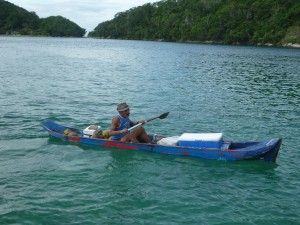 After this we stopped somewhere for lunch which was really tasty. Then our last stop was the bay of love, but by this time the clouds had covered the sun and it was quite cold. Also being closer to the main town on Ilha Grande, the water was dirtier and had poor visibility, so we actually decided to head back early.
After this we stopped somewhere for lunch which was really tasty. Then our last stop was the bay of love, but by this time the clouds had covered the sun and it was quite cold. Also being closer to the main town on Ilha Grande, the water was dirtier and had poor visibility, so we actually decided to head back early.
After our time in the relaxed island destination of Ilha Grande was up, we jumped on a ferry and headed towards Rio de Janeiro, the final destination of our tour.
Foz Do Iguaçu
 Foz Do Iguaçu is the town in Brazil that is closest to the Iguassu Falls. The name of the town means meeting of the rivers and has a population of approximately 30,000.
Foz Do Iguaçu is the town in Brazil that is closest to the Iguassu Falls. The name of the town means meeting of the rivers and has a population of approximately 30,000.
Iguassu Falls
The falls, sometimes spelled Iguaçu, Iguazu or Iguassu are one of the new seven natural wonders of the world. Iguassu means great or big water and rightfully so! The average water flow of the falls is between 900-1500 m3 per second.
The Iguassu Falls are referred to as falls because there are multiple waterfalls along the river. The main fall is the Devil’s Throat.
The falls themselves border on Brazil and Argentina. 75% of the waterfalls are in Argentina and the remaining 25% in Brazil. The vast majority of the UNESCO protected national park is in Brazil and is 185,000 hectares in size.
The national park is an amazingly diverse area, home to: 72 species of mammals; 300 species of birds; 57 species of reptiles; 27 species of amphibians; 800 species of butterflies and innumerable species of insects.
The Brazilian side of the falls is generally where you go to get a great view of the falls. The Argentinian side is where you can really visit the falls; stand on platforms above them, hike the trails between them and even jet boat under them. The site gets an average of 1.5 million visitors per year; the record number of visitors in one day on the Brazilian side was 17,000.
If you are going to the falls then I would say you need at least two days, though I know I could happily spend even longer there. You don’t need a whole day for the Brazilian side, but you certainly need at least a full day on the Argentinian side.
Some tips for visiting the falls:
- do the helicopter ride over the falls, it’s absolutely worth the money
- go to the Argentinian side very early in the morning and head straight up the upper trail to the Devil’s Throat. Later in the day it will be much too over crowded
- do the jet boat ride up the river and under the falls, it’s AMAZING and SOOOOOO MUCH FUN!!! (but pack a spare pair of clothes, because not a stitch will be dry after the boat ride!)
- don’t carry a plastic bag or food with you, the locals animals, coatiemundi, will try to thieve it and they are terrifying! (Ok, everyone knows that I am terrified of basically all animals, but it was genuinely terrifying to have a pack of raccoon type rodents trying to get at you!!)
I’m once again at a bit of a loss for words to describe the falls; they are amazing; sublime; powerful; breathtaking and almost every other superlative I can think of. The roar of the Devil’s Throat is deafening and its spray has you soaked in minutes, but you can’t look away from something so majestic. The power of the water is such a challenge to comprehend.
Itaipu Dam and Animal Sanctuary
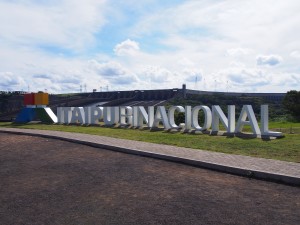 Half an hour out of Foz Do Iguaçu is the Itaipu Dam, which is the only binational place/company I have come across. The hydroelectric dam is one of the biggest in the world. It is 2.5kms wide and roughly 500metres high. It spans Brazil and Paraguay. While you can’t border cross through the dam, you can technically visit the other country without requiring a visa (this also means no passport stamp). The power produced belongs 50% to Brazil and 50% to Paraguay. Of it’s portion Paraguay uses 10% to power 95% of the country and sells the remaining power back to Brazil. The quick tour we did of the Dam was quite fascinating, but for us it was not the main attraction.
Half an hour out of Foz Do Iguaçu is the Itaipu Dam, which is the only binational place/company I have come across. The hydroelectric dam is one of the biggest in the world. It is 2.5kms wide and roughly 500metres high. It spans Brazil and Paraguay. While you can’t border cross through the dam, you can technically visit the other country without requiring a visa (this also means no passport stamp). The power produced belongs 50% to Brazil and 50% to Paraguay. Of it’s portion Paraguay uses 10% to power 95% of the country and sells the remaining power back to Brazil. The quick tour we did of the Dam was quite fascinating, but for us it was not the main attraction.
When anything is built, despite is being productive progress, there is always damage along the way. The creation of such a large dam, obviously had a big impact on the environment. To compensate a sanctuary was created nearby the dam with a focus on rehabilitating injured animals, regenerating forests, doing research into medical and scientific uses of plants, ecological sustainability; all the while running educational programs about all these issues as well.
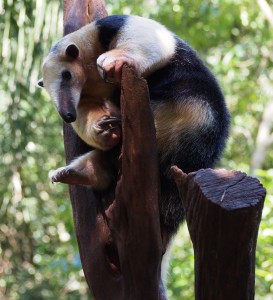 We had the opportunity to do a quick tour of the animal sanctuary. We weren’t able to see any animals that were very share or very injured as we could negatively impact them. However, we were able to see animals that were well on their way to recovery or being held for scientific and reproductive purposes.
We had the opportunity to do a quick tour of the animal sanctuary. We weren’t able to see any animals that were very share or very injured as we could negatively impact them. However, we were able to see animals that were well on their way to recovery or being held for scientific and reproductive purposes.
It was horrifying to hear the stories of some of the animals. There is particular breed of parrot, it is predominantly green with some other streaks of colour. Legally they cost $4000 reales to buy, but they can be bought on the black market for much less. People try to smuggle them into Brazil from Paraguay. One person who got caught had two plumbing pipes, he had filled them both up with tiny chicks of this type of parrot and poured in some alcohol (I can’t remember which type of spirit) to basically drug the birds to sleep, so they wouldn’t make noise as he tried to cross the border. Inside the pipes 70 chicks were discovered, only five of which survived. We were horrified to hear this, but thankful to hear that the Brazilian government has a very tough stance on the issue, the fines and jail terms are hefty.
Despite some horror stories, it was fantastic to hear just how much was being done to support the environment and the animals. There seem to be policies in place, that if you damage the environment in any way, you have to make up for it by affecting the environment positively. In our visit we were lucky enough to see happy and healthy animals, including an ocelot, ant-eaters, ferrets, capybara’s deer, monkeys, caymans, tapir, loads of different varieties of birds and snakes, and the highlight – a pair of jaguars.

Uruguay
 Colonia del Sacramento
Colonia del Sacramento
Colonia is a 1hour fast ferry from Buenos Aires. The Portuguese founded Colonia in 1680 in order to smuggle goods across the Rio de la Plata into Buenos Aires. It’s quite a small town with a population of around 24,000.
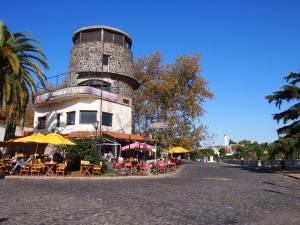 The old part of town is super cute with its cobblestone streets and narrow alley ways. You really only need an hour or two to explore fully, but it’s incredibly pleasant. It’s particularly lovely to sit by the waterside and enjoy a lazy lunch.
The old part of town is super cute with its cobblestone streets and narrow alley ways. You really only need an hour or two to explore fully, but it’s incredibly pleasant. It’s particularly lovely to sit by the waterside and enjoy a lazy lunch.
By the water is also a fantastic spot to watch the sun set over Buenos Aires. A group of us enjoyed a glass of wine and the sunset. It was such a brilliant way to end the day.
Montevideo
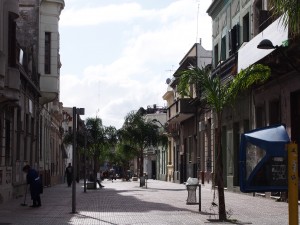 Montevideo is the capital city of Uruguay, it’s quite a bit bigger than Colonia.
Montevideo is the capital city of Uruguay, it’s quite a bit bigger than Colonia.
The newer part of town really feels like any other big city. The old part of town is quite a bit cuter and has cobbled streets.
 The Mercado del Puerto was a great spot to stop for lunch as it had some amazing food. Something I appreciated was that if you say at the bar, rather than a table, you didn’t have to pay the extra table service cost (cubiertos), which you get charged everywhere else.
The Mercado del Puerto was a great spot to stop for lunch as it had some amazing food. Something I appreciated was that if you say at the bar, rather than a table, you didn’t have to pay the extra table service cost (cubiertos), which you get charged everywhere else.
The local drink in Uruguay is Medio y Medio (half and half), a mix of white wine and sparking white wine. It’s a little on the sweet side, but otherwise delicious; a great accompaniment to any meal.
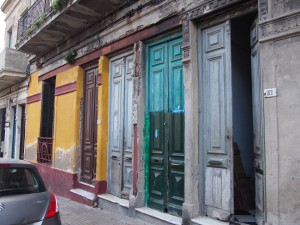 Wandering the streets of the old town you can see some lovely older houses, some brightly painted doors and the occasional piece of street art. There are also some gorgeous old buildings with European architecture. It’s quite an interesting city, but again, not a place to spend a large amount of time.
Wandering the streets of the old town you can see some lovely older houses, some brightly painted doors and the occasional piece of street art. There are also some gorgeous old buildings with European architecture. It’s quite an interesting city, but again, not a place to spend a large amount of time.
Panagea Ranch
Panagea Ranch is a working cattle and sheep ranch somewhere in the middle of Uruguay. The ranch is run by Juan Manuel and his family. Years ago there was an economic crisis in which the people were struggling to make ends meet. On top of this was an epidemic of foot and mouth disease and all the cattle had to be killed.
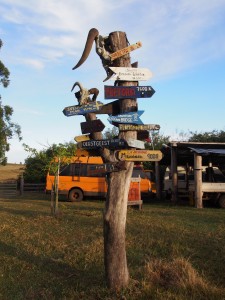 Juan came up with two solutions to the problem for his ranch, one was to accept visitors to pay for a real Uruguayan ranch experience, the other was to have friends and family from overseas invest in a new herd of cattle. The family did both of these things and now appear to be doing really well.
Juan came up with two solutions to the problem for his ranch, one was to accept visitors to pay for a real Uruguayan ranch experience, the other was to have friends and family from overseas invest in a new herd of cattle. The family did both of these things and now appear to be doing really well.
The ranch is 2400 acres, with 1100 cattle, 1800 sheep and 74 horses. The cattle are used for breeding and the sheep for wool.
The ranch homestead is quite basic and only has three hours of generator electricity per day. Despite this it is very homely and comfortable, and even has hot water 24 hours per day.
On our first day on the ranch we learned to saddle up the horses and ride gaucho style. We went for a ride around the farm in the morning; in the afternoon we mustered cattle for vaccination against foot and mouth disease (a vaccination I am told is provided for free by the Government).
The second day we mustered more cattle, vaccinated and tagged them and then started the process of weaning the calves from their mothers. At the end of the day we moved one last herd of cattle to another pasture to graze and rode home as the sun was setting and the rain was starting. As our last full day on the ranch we enjoyed the evening with good food and wine; and while we still had power we had good music and dancing.
The ranch lifestyle might not be great for me long term, but short term it was an absolute blast and I think everyone travelling to Uruguay should give it a go!!
Buenos Aires
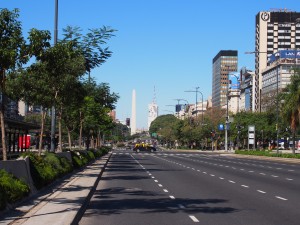 Buenos Aires is a sprawling city. Each suburb has something a little different to offer.
Buenos Aires is a sprawling city. Each suburb has something a little different to offer.
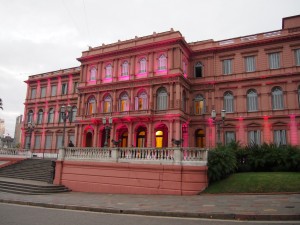 City Centre
City Centre
Buenos Aires Free Walking Tour
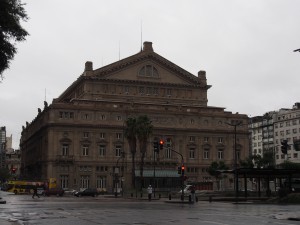 I did a free walking tour, the guide was a uni student called Loli. The tour was about four hours of walking starting in downtown Buenos Aires near the famous opera house Teatro Colon (the day previously I did a tour of the theatre and it was just amazing!!!! A gorgeous theatre to see and a brilliant tour) and finishing at the Cemetary of Recoleta. The walking tour was amazing and we learned summary versions of the history and evolution of Buenos Aires.
I did a free walking tour, the guide was a uni student called Loli. The tour was about four hours of walking starting in downtown Buenos Aires near the famous opera house Teatro Colon (the day previously I did a tour of the theatre and it was just amazing!!!! A gorgeous theatre to see and a brilliant tour) and finishing at the Cemetary of Recoleta. The walking tour was amazing and we learned summary versions of the history and evolution of Buenos Aires.Recoleta
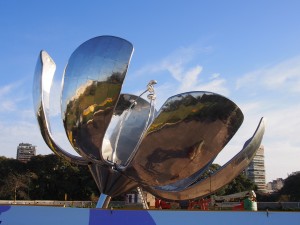 Recoleta is a suburb a few kilometres out of downtown Buenos Aires. It’s a super chilled area, with many cafes, markets and sculptures.
Recoleta is a suburb a few kilometres out of downtown Buenos Aires. It’s a super chilled area, with many cafes, markets and sculptures.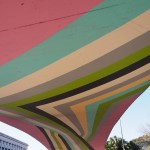 The highlight of Recoleta is actually the cemetery, the most expensive real estate in town!! The cemetery looks basically like a mini city, with many different ‘streets’ and the mausoleums each look like mini houses. It’s simply so fascinating to wander around and look at all the different styles of mausoleum. It’s also interesting to peer through the windows to see what ‘goodies’ were left to people in their afterlife – bridal flowers, books, photographs and more. Though I found it terribly sad each time I saw a child coffin. The mausoleums were predominantly for entire families, so many had multiple tiers of coffins shelved within them. Also they used to be used for storage as many people ran out of storage in their homes.
The highlight of Recoleta is actually the cemetery, the most expensive real estate in town!! The cemetery looks basically like a mini city, with many different ‘streets’ and the mausoleums each look like mini houses. It’s simply so fascinating to wander around and look at all the different styles of mausoleum. It’s also interesting to peer through the windows to see what ‘goodies’ were left to people in their afterlife – bridal flowers, books, photographs and more. Though I found it terribly sad each time I saw a child coffin. The mausoleums were predominantly for entire families, so many had multiple tiers of coffins shelved within them. Also they used to be used for storage as many people ran out of storage in their homes. I’m not normally into cemeteries, but this place was throughly fascinating. It does also have the mausoleum of Eva Peron, the only one to be visited regularly and have fresh flowers.
I’m not normally into cemeteries, but this place was throughly fascinating. It does also have the mausoleum of Eva Peron, the only one to be visited regularly and have fresh flowers.Tango Show
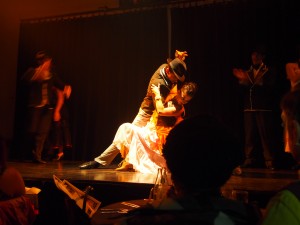 Argentina is known for the Tango. Apparently it originates through men fighting other men to vie for the attention of prostitutes. So the better fighter, or dancer was likely to win the attention of the prostitute. So the Argentines previously didn’t put a lot of importance on the Tango, until Europeans started to recognise it. At which time Argentina claimed it as its own and put more energy into perfecting the dance.
Argentina is known for the Tango. Apparently it originates through men fighting other men to vie for the attention of prostitutes. So the better fighter, or dancer was likely to win the attention of the prostitute. So the Argentines previously didn’t put a lot of importance on the Tango, until Europeans started to recognise it. At which time Argentina claimed it as its own and put more energy into perfecting the dance.La Boca
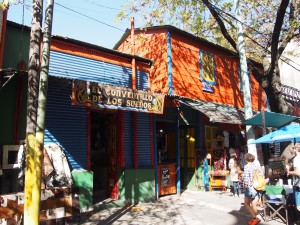 The Italian region of Buenos Aires is called La Boca. It has become famous for it’s Calle Caminito (Caminito Street) which is lined with brightly coloured buildings, most of which are multi-coloured. It’s an amazingly colourful area, very interesting to wander.
The Italian region of Buenos Aires is called La Boca. It has become famous for it’s Calle Caminito (Caminito Street) which is lined with brightly coloured buildings, most of which are multi-coloured. It’s an amazingly colourful area, very interesting to wander.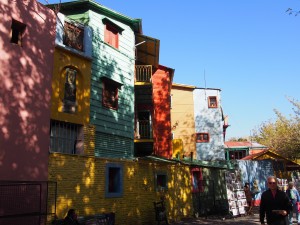 It is so clearly a tourist trap, all the souvenir stores and restaurants have hiked up prices. Tango dancers line the streets ready to pose for a photo with you just so they can charge you for the privilege.
It is so clearly a tourist trap, all the souvenir stores and restaurants have hiked up prices. Tango dancers line the streets ready to pose for a photo with you just so they can charge you for the privilege.Puerto Madero
 Buenos Aires is actually a fairly major port and the port area Puerto Madero was developed to support the shipping, however once it was finally built it was only used for 9 years before the cities shipping needs had outgrown the port. So the port was moved further away and made larger.
Buenos Aires is actually a fairly major port and the port area Puerto Madero was developed to support the shipping, however once it was finally built it was only used for 9 years before the cities shipping needs had outgrown the port. So the port was moved further away and made larger.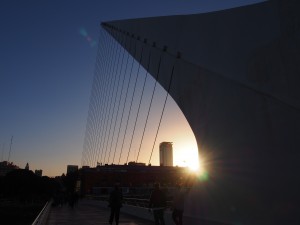 The Puerto Madero area is now super trendy and both sides of the port are lined with restaurants and cafes. Having grown up near the water, this was the area I felt most relaxed in Buenos Aires. It was a great spot to sit with a lemonade and people watch.
The Puerto Madero area is now super trendy and both sides of the port are lined with restaurants and cafes. Having grown up near the water, this was the area I felt most relaxed in Buenos Aires. It was a great spot to sit with a lemonade and people watch.El Zanjon de Granados
 One archaeological site that I went to fairly last minute was just phenomenal; El Zanjon de Granados is a private museum in San Telmo. Many years ago it was the homestead of a well off family, tunnels were built over the creeks running underneath and houses were built above. As sickness spread in the areas, through the creeks and via the river, the wealthy families sold their houses and moved to a different area of town. The houses then became used a cheap tenement housing. Many years later a gentleman bought one of these houses to convert to a restaurant. As he started to renovate, he discovered the tunnels and the rich history of the property and went about restoring it. As restorations went on he discovered more tunnels under his neighbours properties and purchased the tunnels (but not the houses) off them.
One archaeological site that I went to fairly last minute was just phenomenal; El Zanjon de Granados is a private museum in San Telmo. Many years ago it was the homestead of a well off family, tunnels were built over the creeks running underneath and houses were built above. As sickness spread in the areas, through the creeks and via the river, the wealthy families sold their houses and moved to a different area of town. The houses then became used a cheap tenement housing. Many years later a gentleman bought one of these houses to convert to a restaurant. As he started to renovate, he discovered the tunnels and the rich history of the property and went about restoring it. As restorations went on he discovered more tunnels under his neighbours properties and purchased the tunnels (but not the houses) off them.
